

How to Shoot Night Photography with the Olympus Trip 35 by Tom Box
- Learn to Shoot Film: Tips & Tutorials
- January 25, 2019

Written by Tom Box

I would imagine most, if not all, of the people reading this have heard of the Olympus Trip 35
Over 10,000,000 units of the camera were sold during it’s lifetime, and the solid build, simple operation, and wide availability have made the Trip a hugely popular option for the modern film crowd.
I’m not going to review the camera, as this has been done dozens of times across the internet, but instead explain how to use the Trip outside of its limits, specifically with low light and night photography.
Find the Olympus Trip 35 at KEH Camera or on eBay .

Hacking the Olympus Trip 35 to Work in Low Light
The Olympus Trip 35 uses a selenium light meter to adjust aperture and shutter speed automatically, locking the shutter release if there is insufficient light which would result in underexposure.
However, the Trip also has a flash sync mode, whereby the aperture is manually selected and the shutter is set to it’s slower speed of 1/40th of a second.
This is, of course, designed to be used with a flash, but the manual aperture settings coupled with modern high speed films means you can also use the flash setting to successfully shoot the Trip at night. Don’t let that little red flag stop you…
Load a roll of 400 or 800 speed film, set the ASA to 400 and the aperture to it’s widest setting of 2.8, and you’re ready to go. That’s all there is to it.
If the scene is too bright for the set aperture of 2.8, don’t worry, the Trip’s meter is still active in flash mode and will stop down the aperture to prevent overexposure.
Related: Five Tips for Shooting Film at Night
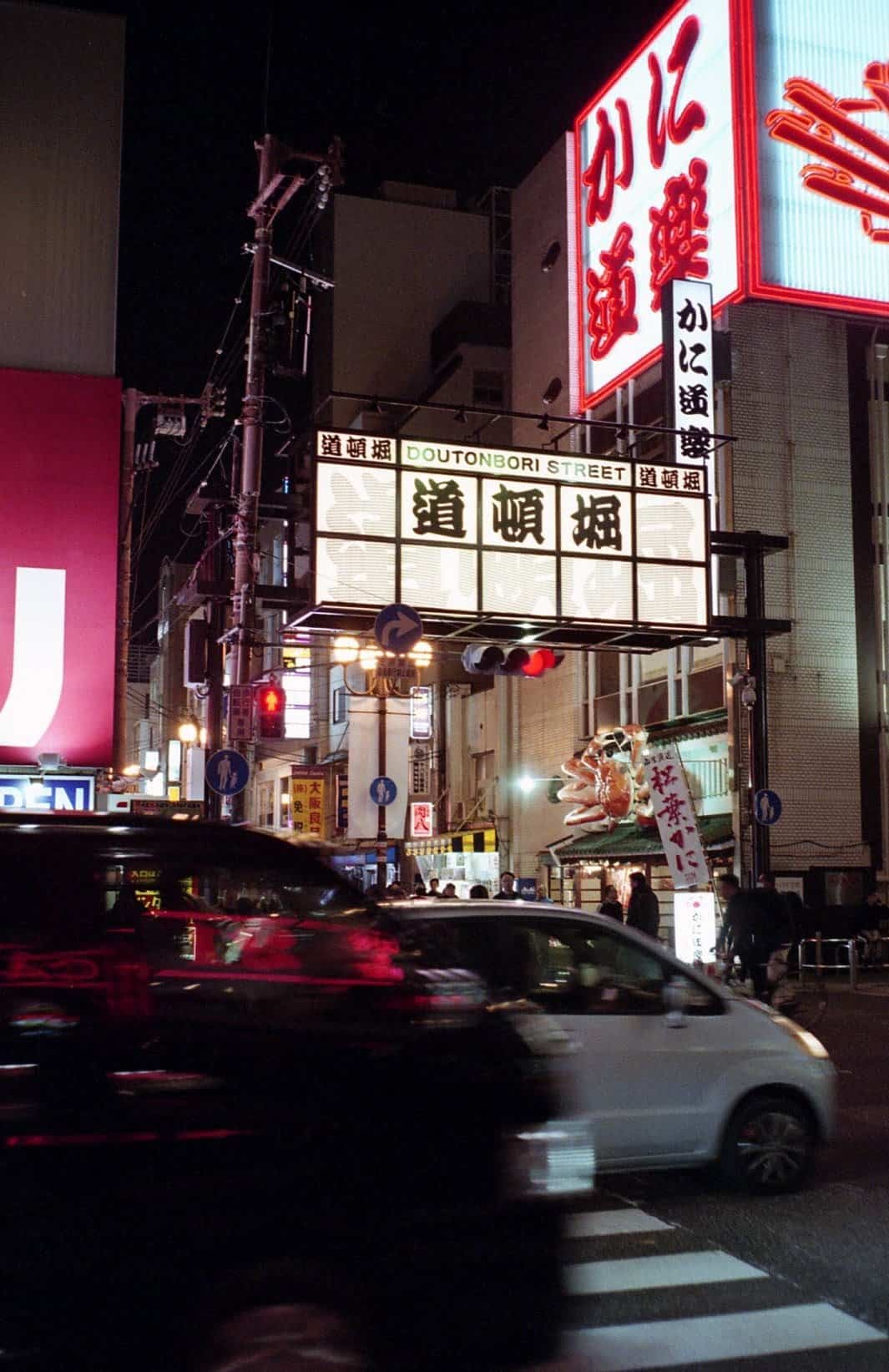
Working With the Shutter Speed and Aperture Limitations
Now, 1/40th at f/2.8 really doesn’t seem slow or wide enough to shoot at night, even with 800 speed film. But I’ve found that I get excellent results if there are enough bright lights in the scene.
I used to shoot SLRs at night on aperture priority, lens wide open to f/1.4, and, even pointing at a shop window, I’d be struggling to hand hold the camera’s chosen 1/15th or 1/8th shutter speed.
The thing is, most auto-exposure cameras will be metering for the whole scene, taking into account the vast expanse of black just as much as any light sources.
More often than not, auto-exposure for a scene like a shop window at night would result in a blown out light source and mucky shadows, and not look at all how you remember seeing the scene with your own eyes.
Have you ever tried to take a photo of a sunset with your phone camera and it’s blown out the colors and tried to expose for the foreground? Every time.

What to Expect While Shooting the Olympus Trip 35 at Night
I won’t lie and tell you that using the Olympus Trip ( find on eBay ) at night will always produce perfect results. (It works best in an urban area with lots of artificial light.) But I do believe that shooting film at night can be as simple as setting the exposure once and getting on with taking photos.
An underexposed photo is better than a 2 second long exposure of motion blur!
Any grainy shadows can be clipped in using Photoshop or another image editing program to bring true black back into the shot and increase contrast.
That and slightly boosting the mid tones is pretty much the only editing I need to do to my Night Trip photos.

Related: Olympus Stylus Epic Point & Shoot Film Camera Review
The Olympus Trip 35 is a quintessential point-and-shoot camera, and that doesn’t have to stop when the sun goes down.
Try it yourself with some 400 or 800 speed film and see if you agree that night photography doesn’t always require tripods and fast lenses…
All of the photos in this post were taken on a trip to Japan, using Fuji Superia Premium 400 speed film and my Trip 35 set up as I’ve described. Developed and scanned at home.
I also double exposed a roll of CineStill 800T in the Trip. Photos below.

On a tangent…
It’s always worth checking over a ‘dead’ Olympus Trip 35 because it’s quite likely the meter is fine, and the problem is with gummed up aperture blades or other internal gubbins.
On two occasions, I’ve acquired a Trip which refuses to raise the red flag, suggesting the meter is dead, only to remove the top plate (held on by 3 easily accessible screws) and see that the meter needle is moving fine.
The problem both times lay in the sliding plates that determine aperture and shutter speed. A quick clean with naptha and it was working perfectly.
I’ve had a similar experience with an Olympus Pen EES-2 (basically the half frame Trip 35) which merely had sticky aperture blades. Half an hour of disassembly and cleaning and it’s working beautifully.
Thank you so much, Tom! Tom is a regular contributor here at Shoot It With Film, and you can check out his other articles here , like an intro to pinhole film photography and how to use prisms for creative effect . You can also check out Tom’s work on his website and Instagram .
Leave your questions about shooting the Olympus Trip 35 at night below in the comments, and you can pick one up for yourself at KEH Camera or on eBay !
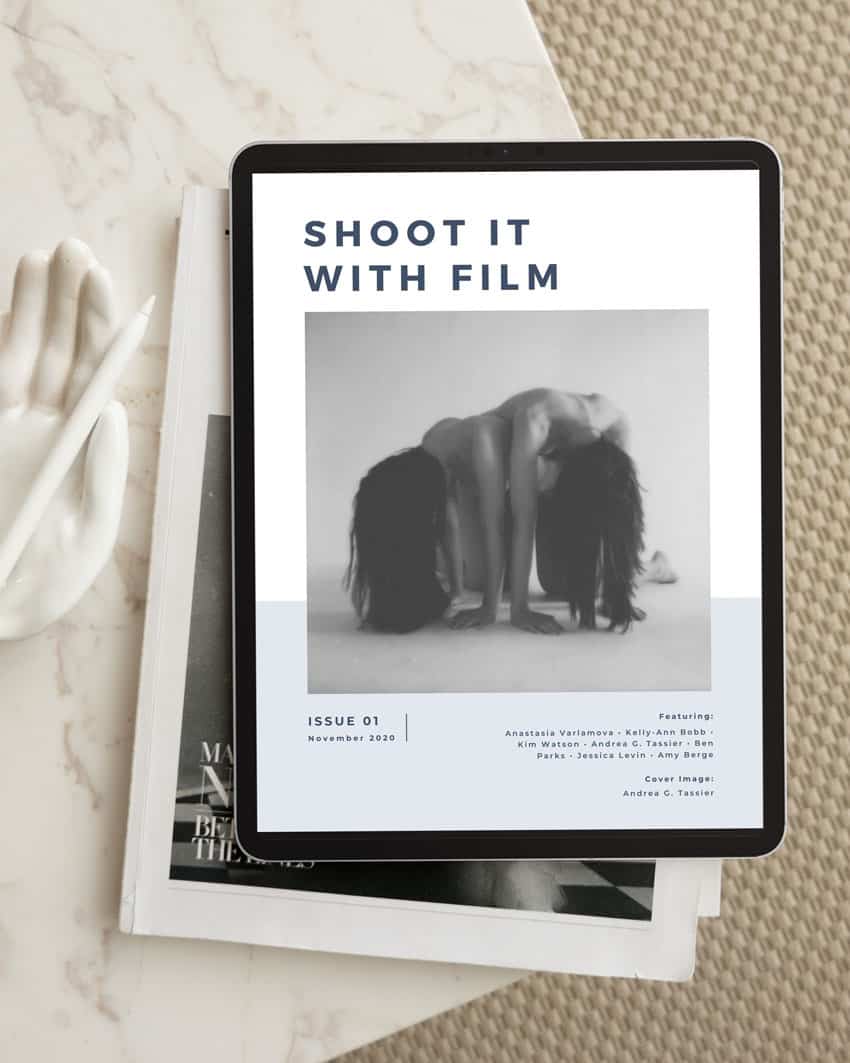
Related Posts:

Blog Comments
Noor Hashem
January 1, 2020 at 7:38 pm
Can i use a 200 speed film or does it have to be 400 or 800?
July 27, 2020 at 5:54 am
Hi Tom, Can you use the Fuji Superia Premium 400 speed film also during the day or you would recommend it only for night shots?
Many thanks! Px
shootitwithfilm
July 27, 2020 at 2:48 pm
Thanks for your comment, Pilar! Fuji Superia 400 is a great film to use during the day. You can check out this post for examples of what it looks like during the day: https://shootitwithfilm.com/how-to-shoot-fujifilm-superia-400/
January 22, 2021 at 8:21 am
How did you do the double exposure on the Cinestill 800T’s pics ?
January 25, 2021 at 2:22 pm
The double exposures were totally random, done by shooting a full roll, rewinding it almost to the end and then shooting over it again. – Tom
April 12, 2022 at 7:59 pm
Hi, I´m planning to use a Fuji 500T for night concert shots in my Olympus trip. Do I have to detail this to the photography laboratory? Any recomendation?
April 12, 2022 at 11:14 pm
Hi Morena! If you want it developed and scanned normally, you don’t need to let the lab know any special information. You’ll only want to let the lab know if you want the film pushed in development or if you want the film scanned a specific way (such as having it scanned for highlights to bring out the nighttime atmosphere of the images). And while you don’t have to let the lab know any special info, if you feel like it was a tricky shooting situation, you can always reach out to the lab and ask their advice for developing and scanning.
September 10, 2022 at 4:07 pm
I just purchased this camera and the red shutter flag appears over my view finder whenever it is set to automatic. I have not yet tested with film yet but my run through seems to work okay when the apture is set to any other setting (2.8-end). What does this mean? That my internal light source is dead? And if so what does this mean when shooting? Shall I just set it to sunny 16 (as a rule of thumb) but how will this look in low light?
Leave a Comment Cancel Comment
Shoot it with film on instagram.

Olympus Trip 35 Film Camera Review
A cult classic, an engineering marvel, and an excellent value for a modern film photographer.
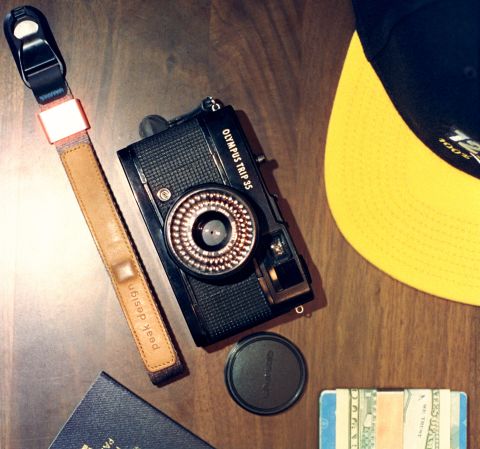
Olympus Trip 35 is one of the most popular 35mm film cameras ever produced. It’s affordable, it’s easy to use, the lens is sharp, it needs no batteries, and it’s compact.
Trip 35 uses a scale focus system, which may seem daunting at first — but it’s not difficult, and the camera has unique aides to help you get the right distance — I’ll explain below.
I’ll also cover all the basics of operation (including the auto and manual modes), lens performance, and build quality of this excellent entry-level Olympus film camera .
A Cult-Classic, Engineering Marvel, an Excellent Value for a Modern Photog
Why is Olympus Trip 35 a favourite of so many photographers?
Olympus Trip 35 is not an expensive camera. It has decent specs, but it’s not the sharpest, fastest, or most compact camera. Yet, it’s loved by many photographers of all levels today.
Back when it was introduced — over 55 years ago — it was a huge hit. The camera was in production for 15 years, having sold between five and ten million units .
Trip 35 sold for $59.95 at launch in 1968, or $530 in today’s money. But you may still find a working copy for $50 in 2024!
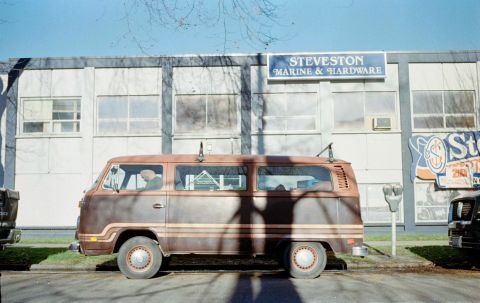
But it’s not just the price that makes this camera good. Trip 35s are built very well with lots of metal components and an excellent glass lens. They are a pleasure to hold and use. They’re nearly pocketable and don’t require any advanced photographic know-how or a manual to get started: if you know how to load film , you can use this camera.
🤓 Trip 35’s automatic exposure system that chooses an aperture and shutter speed by converting light energy into mechanical force is of particular interest to film nerds like me. Though many fancy cameras from the era used selenium light meters for aperture or shutter-priority modes, Trip 35 combined both functions in a relatively simple and remarkably reliable design .
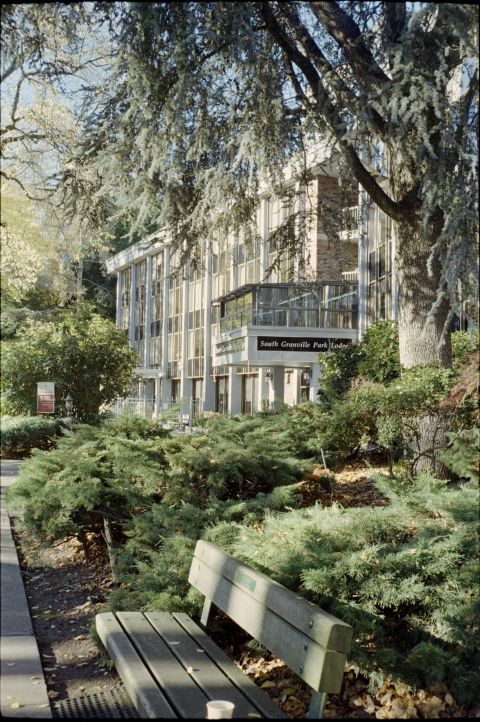
Olympus Trip 35 specs and features.
Trip 35 is a successor to Olympus PEN (namely, EES and EES-2) cameras’ excellent mechanical/optical design and portability.
My black paint brass Olympus Trip 35 version weighs 413g/14½oz , though some copies of this camera may weigh up to 20g lighter. The camera is nearly pocketable at 12×7×6cm (4 ½ ×2¾×2¼”), though it’s not the smallest .
Olympus Trip 35’s remarkably small (for the time) dimensions and ease of use are undoubtedly at the core of this camera’s name and ethos: a camera that’s easy to throw in a small bag or a pocket for a trip.
☝︎ Further reading: “ How to Travel With Film Through Airport Security .”
The leaf shutter on Olympus Trip 35 has two speeds: 1/40s and 1/200s. It can switch between the two automatically via the mechanical trap-needle system. In manual mode, Olympus Trip 35 only uses the 1/40s shutter speed. There are no Bulb and no self-timer modes.
The lens is a non-interchangeable Olympus D. Zuiko 40mm 𝒇2.8-22 (four elements in three groups). The closest focus distance is 1m/3ft. The lens uses an odd 43.5mm screw-in lens filter thread that can be adapted to the more common 40 or 46mm threads .
Fully automatic exposure (A) is controlled mechanically by converting ambient light energy via selenium cells (bubbles around the lens) into mechanical movements that modify the aperture and shutter speeds. The camera can be operated manually via the aperture ring around the lens, which will always trigger the shutter at 1/40s if not set to A. The exposure meter is operational between EV8 and EV17 ; it accepts films with ISO 25 — ISO 400 (which needs to be dialled in manually before shooting). No batteries needed.
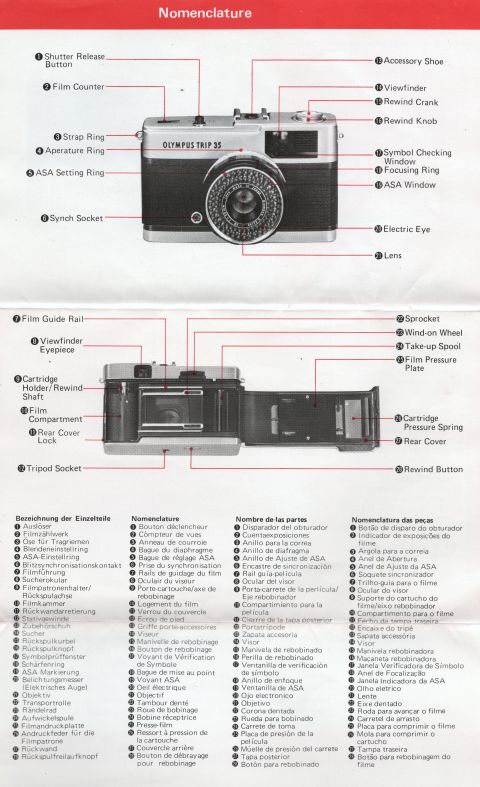
The viewfinder features a mechanical “red flag” warning system for scenes with insufficient lighting (the camera will also prevent exposures in those conditions). It shows bright lines with parallax markings inside a small but bright window with 0.55x magnification. The eye relief isn’t great, but if you aren’t wearing glasses, you’ll notice a “ Judas window ” that overviews the camera’s shooting mode and distance settings.
Film advance is done with a thumb wheel; rewinding via the rewind knob is unlocked with a rewind button; the film cover opens with a small latch a the bottom-left when looking at the camera’s back.
Hot shoe and a PC socket are available for flash sync. Learn how to use flash with cameras like Trip 35 here .
Free Olympus Trip 35 manual download.
I’ve recently scanned the manual that my camera came with and converted it to a convenient PDF file that you can download for free here:
➜ Free Download : Olympus Trip 35 Instructions Manual (PDF)
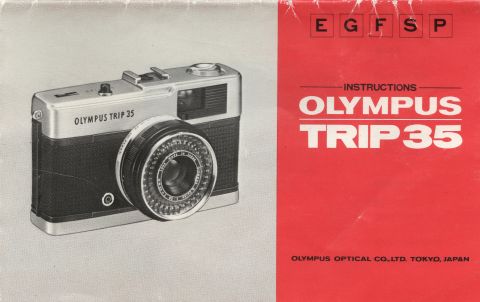
This manual took some cropping and assembly as its pages aren’t standard (it’s folded like a map). I hope that this little bit of extra effort makes it easier to read on your screen. However, I’m not sure how well it will look in print.
You’ll be asked to sign up for a free account with Analog.Cafe. It comes with access to more downloadable guides, additional website features, and a monthly community newsletter.
Taking the first photo with Olympus Trip 35: loading film & setting focus.
Trip 35 is easy to load — the only tricky part is finding the latch to open the film door. ( If you’ve never loaded film in these types of cameras, check out this guide .)
Given that you’ve loaded your Trip 35 with film rated between ISO 25 and 400, you’ll need to set the ASA/ISO dial to match your film speed . In general, ISO 100-400 films do best with this camera (a higher-ISO film works best in subdued light, and lower-iso film provides finer grain).
For automatic exposures, the ring around the lens closest to the camera body should be set to “A.” But manual exposures are possible at the constant 1/40s shutter speed (can be metered as 1/30s) with the apertures selected via the same ring (i.e., any number other than the “A”). Learn how to shoot film cameras in manual mode here .
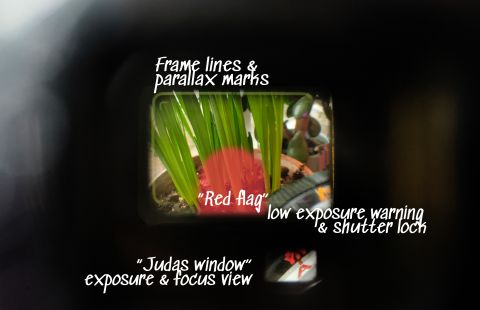
I appreciate the bright frame lines with parallax markings in the viewfinder . They make framing feel a little easier than on cameras with masks . Though I would prefer the self-illuminating kind.
The viewfinder window is fairly small. It’s usable with the glasses on; however, I had to use contacts to take advantage of the “Judas window” — a small secondary view below the main finder frame lines that shows the set distance icon and camera shooting mode/aperture.
Pointing the camera at things that are insufficiently lit for the film ISO/ASA set on the camera would raise a small translucent red plastic flag and block the shutter button. This would not happen when the camera is in manual mode (i.e. when an aperture value is selected instead of the “A”).
Olympus Trip 35’s shutter button provides medium-high resistance, it has a long travel distance, and it’s very well-balanced with the rest of the body for shake-free hand-held exposures . The leaf shutter is also shake-free (though it feels a little loud for what it is ).
Trip 35 uses a zone-focusing system. For a casual photographer, it works by turning the focus ring around the lens until it clicks to either a single-person icon 👤 for portraits, a two-person icon 👥 for group portraits, a red “group-snap” icon ⍒.⍒ , or the mountains icon 🏔️ for landscape photos.
Below the lens barrel, there are more precise focus markings in feet and metres. Learn how to zone-focus quickly and accurately here .
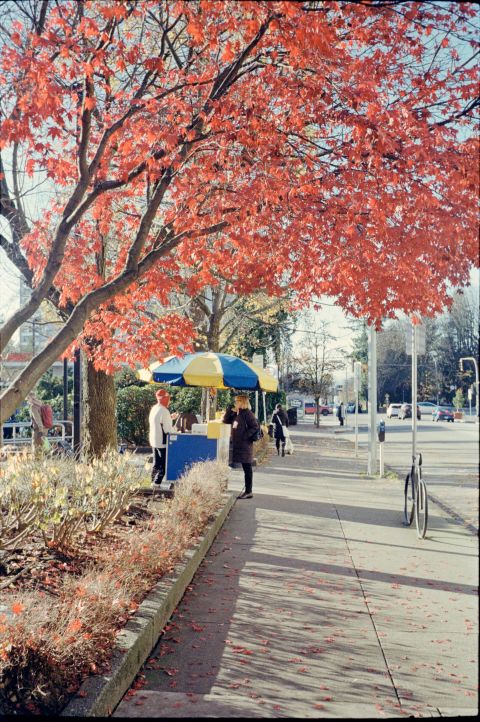
Olympus D. Zuiko 40mm 𝒇2.8 lens.
One of the most celebrated components of this camera is its lens. It’s very sharp in the middle , especially at 𝒇5.6-8 , with only minor swirl and softening in the corners.
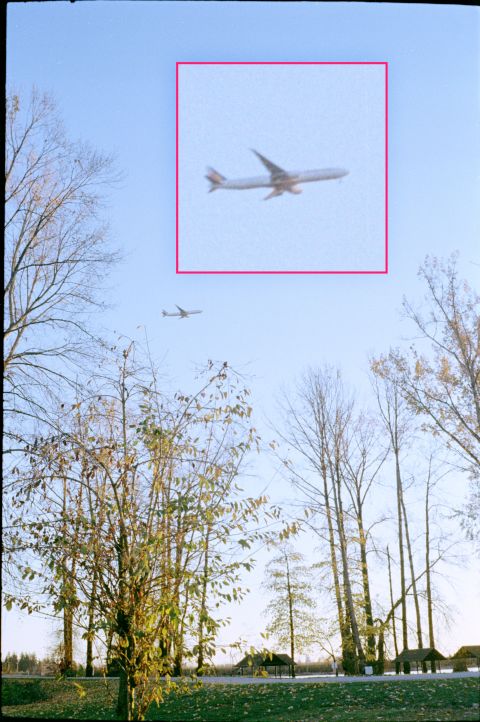
The lens renders a medium-low amount of contrast on my copy, but the coating appears to work well, as I noticed no overwhelming or unexpected flaring in any of my photos.
Overall, I found D. Zuiko 𝒇2.8 well-corrected, suitable for reproducing fine detail on high-resolution films.
The 40mm focal length is common and well-suited for a non-interchangeable camera system. It translates to ~57° diagonal angle of view — very close to the 60° in our central vision . Essentially, this means easy framing for most situations.
The 40mm D. Zuiko may not be appropriate for interior/architecture photography, close-ups, telephoto, or certain landscape images.
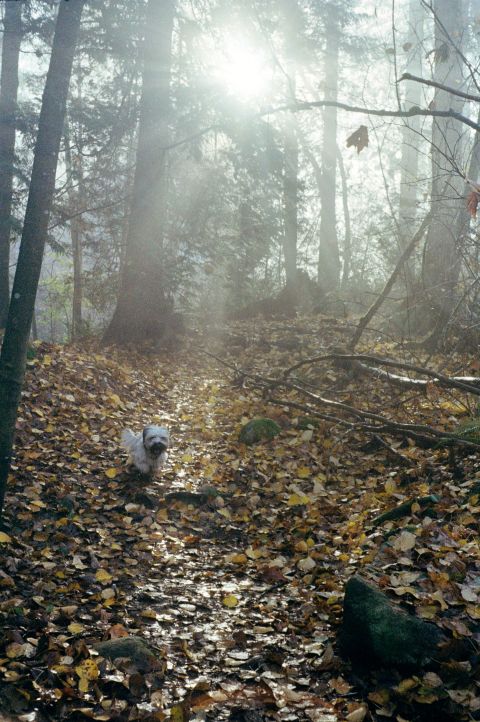
Olympus Trip 35 portability and ease-of-use (ergonomics).
Even though Trip 35 isn’t the smallest or the lightest 35mm film camera , it’s reasonably portable for the type of lens it uses and a full metal body. All of its controls are perfectly positioned for quick, intuitive action. With a little practice, you can use this camera one-handedly.
I kept mine in wool jacket pockets and hoodies with no issues. Despite fitting will in hand, Trip 35 is noticeably hefty; my Peak Design wrist strap solved any danger of dropping this camera.
Olympus Trip 35 build quality & variations.
Trip 35 was a remarkably successful design; understandably, Olympus didn’t want to change it much while it continued to make record sales. All of the Olympus Trip 35s look nearly identical, with some known changes introduced in the 1970s that had little effect on appearance and no effect on performance (i.e. a plastic shutter button instead of the metal one).
The only significant divergence from the standard design was the black paint brass Trip 35 , which remained in production for just two years. This variation is much rarer than the silver aluminum bodies, but in Olympus’ world, this means that there are less than a hundred options available at any time, and they cost $50 extra.
If you plan to keep this camera for a while and are willing to spend a little more, the black version may be worth it (if you like the look of brassing). It has excellent build quality and an impressive appearance; every part fits perfectly, in line with what you’d expect from the much more expensive Olympus PEN half-frame SLRs .
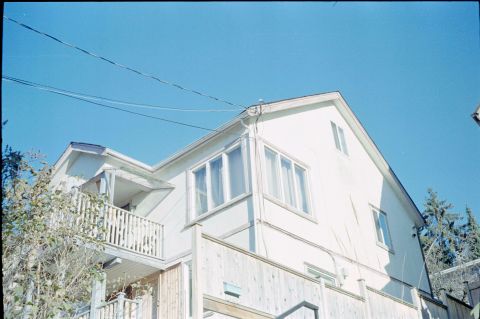
But despite their clever design and quality assembly, Trip 35s can be prone to deterioration.
In my copy, the light meter over-exposes every brightly lit frame by 1-2 stops. It’s difficult to say if it’s the time taking a toll on the intricate cells or if it’s the imprecise nature of the selenium metering that’s preventing me from taking perfectly exposed images.
A clever photographer can always compensate by setting the film ASA/ISO higher in full sun or shooting Trip 35 manually. But if you’re looking to get a copy, you should verify that the camera is sold as fully functional . An online listing would say that in the title or the description.
Trip 35 mods, hacks, and repairs.
Repairing Trip 35s may cost as much or more than the value of the camera. The good news is that simple fixes (like cleaning oil of the shutter and aperture blades) aren’t difficult if you’ve got the right tools and know-how.
Another common issue with cameras this old is the light seals. The soft, spongy material tends to crumble over time, which in turn can create light leaks . I have a guide on fixing that quickly and cheaply here .
Being a mechanical camera with manual controls, Trip 35s can survive past the span of the selenium cells that power its fully automatic shooting mode. Some photographers may prefer to use the camera in the manual mode for more precise control over exposure. You may even modify yours to shoot with the faster 1/200s shutter speed for improved action snaps and reduced motion blur.
How much does Trip 35 cost, and where to find one.
Olympus Trip 35 film camera is a fantastic value in terms of fun, image quality, and build quality. Most copies of these cameras can be bought between $20-120 — depending on the condition. And a few bucks more can get you the rare-ish black paint version .
❤ By the way: Please consider making your Olympus Trip 35 purchase using this link so that this website may get a small percentage of that sale — at no extra charge for you — thanks!
About this article :
It can take five hours of work (or more) to write and proof a quality five-minute read with high-res illustrations. Below are the people who made this one possible. All content is reviewed, styled, and edited by Dmitri .

Item added to your cart
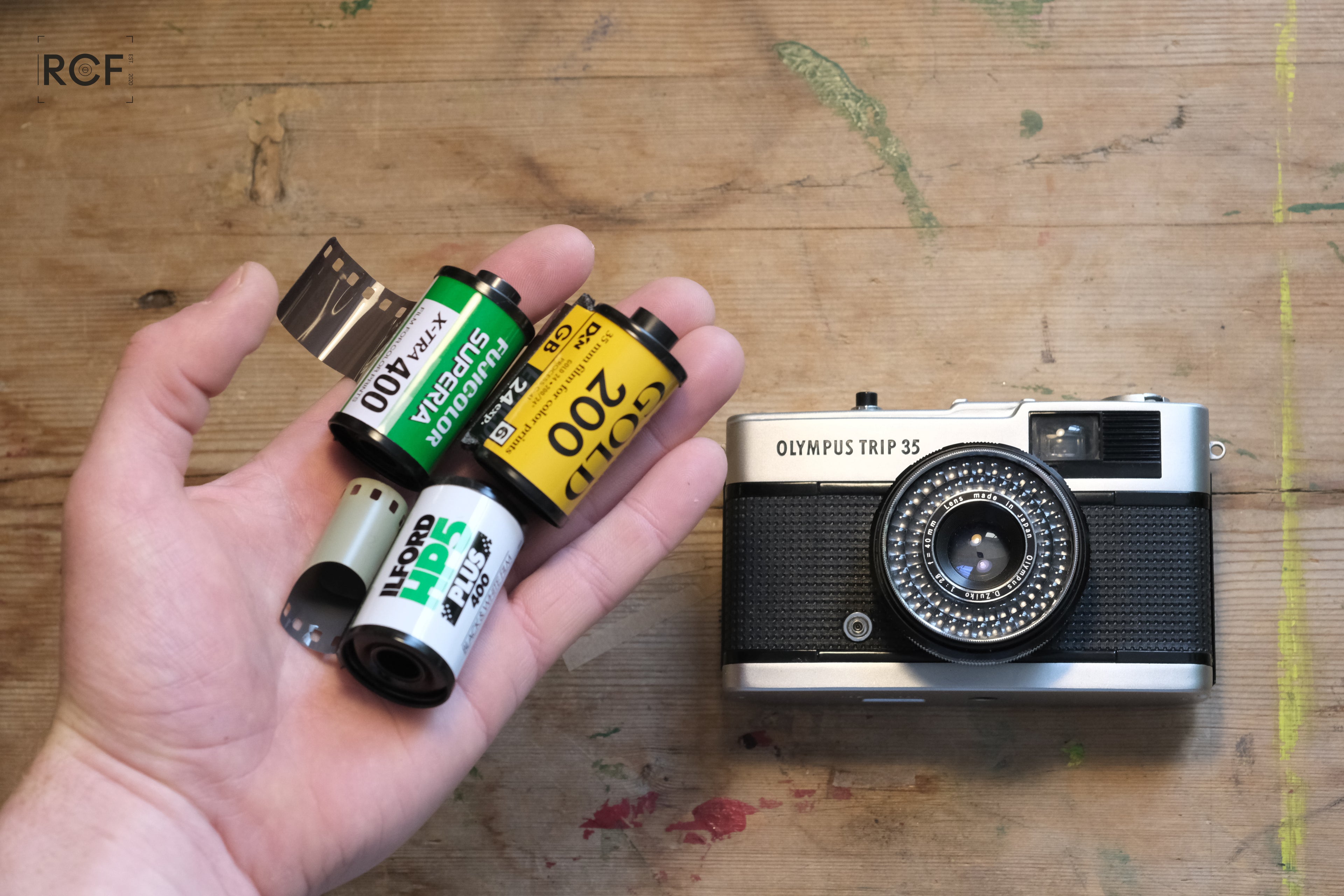
If you're the proud new owner of a vintage Olympus Trip 35 film camera, you're in for a treat! This classic piece of photographic history is perfect for capturing memories with a unique analog touch with ease. In this guide, I'll walk you through the step-by-step process of using your Olympus Trip 35, complete with images and important precautions to ensure you get it right every time.
Expand the relevant guide:
Collapsible content
Loading film into the olympus trip 35:.
Step 1: Choose your film
Select your preferred 35mm film roll, keeping in mind that the Olympus Trip 35 is compatible with ASA/ISO speeds ranging from 25 to 400.

Popular film brands include Kodak, Fujifilm, and Ilford. This post I wrote might be useful: Buying 35mm Film - A Complete Guide
Step 2: Set the film speed and set the camera to manual for film loading
Set the appropriate ASA/ISO speed for your film using the dial located on the front of the camera, near the lens.

Also turn the aperture ring to any manual f number against the red line so that it isn't set to 'A'. The shutter can now be released regardless of light conditions.
Step 3: Open the camera back
![olympus trip 35 timer [Image 2: The Olympus Trip 35's back lock tab]](https://cdn.shopify.com/s/files/1/0571/3212/2301/files/DSCF2797_480x480.jpg?v=1684491064)
Locate the back cover lock tab on the bottom of your Olympus Trip 35. Pull it down and the camera back should pop open.
Step 4: Insert the film cartridge
![olympus trip 35 timer [Image 3: Film cartridge being inserted into the camera]](https://cdn.shopify.com/s/files/1/0571/3212/2301/files/DSCF2798_480x480.jpg?v=1684491072)
Lift up the rewind knob and insert the film cartridge into the film chamber on the left side of the camera, making sure the tip of the film is pointing toward the take-up spool on the right side. Then push the rewind knob back down into the roll of film (sometimes needs a wiggle or slight rotation to go all the way back down).
Step 5: Engage the film leader into the take-up spool
![olympus trip 35 timer [Image 4: Film leader inserted into the take-up spool]](https://cdn.shopify.com/s/files/1/0571/3212/2301/files/DSCF2800_480x480.jpg?v=1684491080)
Pull the film across the camera and insert the tip securely through and into a slot on the take-up spool. Advance the film using the wind-on wheel.
Step 6: Align the film perforations
Ensure that the film perforations are aligned with the sprocket teeth on both sides of the film.
![olympus trip 35 timer [Image 4: Film leader inserted into the take-up spool]](https://cdn.shopify.com/s/files/1/0571/3212/2301/files/DSCF2801_480x480.jpg?v=1684491091)
This ensures the film will advance smoothly when winding.
Step 7: Close the camera back
Close the camera back tightly. The camera back should click shut, indicating it is securely closed.
![olympus trip 35 timer [Image 6: Closing the camera back]](https://cdn.shopify.com/s/files/1/0571/3212/2301/files/DSCF2803_480x480.jpg?v=1684491101)
IMPORTANT: Never open the camera back before fully rewinding the film, as this can expose your film to light and ruin your photos. Make sure to rewind the film completely after taking all 24 or 36 frames before unloading it.
Step 8: Advance film to '1'
Keep winding film and releasing the shutter until the film counter points to "1". This ensures the unexposed part of the film is ready for your first photo.

IMPORTANT: Watch the rewind knob when you wind the camera on ; it should start to rotate at the same time as you wind, indicating that the film has been taken up correctly - this is key, if this is not happening after a few shots then it probably means that the film has not been securely engaged by the take-up spool and the loading process will need to be repeated.

Step 9: Set the camera back to "Automatic" and get ready to shoot!
Turn the aperture ring until the 'A' mark is aligned with the red line in front of the viewfinder (click stop).

Your Olympus Trip 35 is now loaded with film and ready to capture amazing photos.

Taking Photos with the Olympus Trip 35:
How to take photos with the olympus trip 35:.
Step 1: Ensure the camera is wound on
This gets the shutter ready and primed to take a photo.
Step 2: Set subject zone focus distance on the lens
The Olympus Trip 35 has 4 settings which equate to focusing zone distances away from the camera (shown on the underside of the lens barrel):

- 🧍♀️Close focus ≈ 1 meter. This setting is used for focusing on anything ~1 meter away from the camera, be it close headshots or other close up details.
- 👥 Portrait ≈ 1.5 meters. Used for focusing on anything ~1.5 meters away from the camera, for example portraits or capturing wider details in the photo.
- 👯 Group ≈ 3 meters. Focusing on anything ~3 meters away from the camera, eg. full length body shots/group photos.
- 🌄 Scenery ≈ 5+ meters. Focusing on everything 5+ meters away from the camera, great for landscapes or subjects far away from the camera!
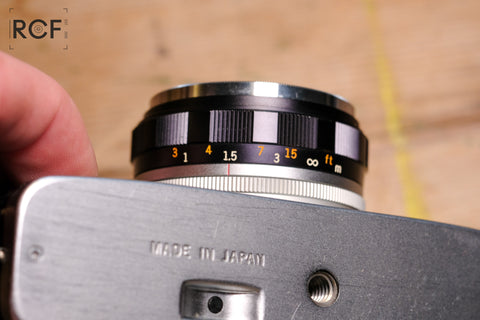
Step 3: Ensure aperture ring is set to 'A'
For 99% of situations in good light without a flash, it's best to leave the camera set to the red 'A'.

This lets the camera's solar powered meter set the exposure settings automatically and ensures a good exposure.
Step 4: Compose the photo using the viewfinder

Use the projected frame lines to see the area that will be captured in your photograph. There are hash marks to indicate the change in frame at close focus.
Step 5: Take photo by pressing shutter button

There should be a small click as the shutter fires - indicating a photo has been taken! 🙌 If instead a red flag appears in the viewfinder, this is a warning that there is not enough light in the scene for a proper exposure.

You can manually disable the red flag low light warning and take a photo anyway in low light by setting the aperture to '2.8'.
Towards the end of the roll it is important to not try to wind on the camera hard when you start feeling quite a lot of resistance or cannot wind on further - this signifies that the roll is finished, but if pushed too hard at this stage can result in the film snapping in the back of the camera.
Unloading Film from the Olympus Trip 35:
Step 1: Check the film counter
Once you've taken all the photos on your film roll (either 24 or 36 frames), check the film counter to ensure you've reached the end.
![olympus trip 35 timer [Image 10: Film counter indicating the last frame]](https://cdn.shopify.com/s/files/1/0571/3212/2301/files/DSCF2809_480x480.jpg?v=1684491137)
Towards the end of the roll it is important to not try to wind on the camera hard when you start feeling quite a lot of resistance - this signifies that the roll is finished and if pushed too hard can sometimes result in the film snapping in the back of the camera.
Step 2: Press rewind button in

Find the small black button on the base of the camera and push it in to disengage the film from the winding mechanism and allow the film to wind back into the film canister inside the camera.
Step 3: Rewind the film
Press the rewind button located on the bottom of your Olympus Trip 35. Then, turn the rewind knob clockwise to rewind the film back into the cartridge. Keep rewinding until you feel the tension release, indicating that the film has been fully rewound.
Step 4: Open the camera back

Following the same steps as when loading the film, locate the camera back lock tab on the bottom of your Olympus Trip 35. Pull it outwards to open the camera back.
Step 5: Remove the film cartridge
![olympus trip 35 timer [Image 13: Film cartridge being removed from the camera]](https://cdn.shopify.com/s/files/1/0571/3212/2301/files/DSCF2813_480x480.jpg?v=1684491173)
Pull up the rewind lever and lift the film cartridge out of the film chamber.
Step 6: Store and develop your film
![olympus trip 35 timer [Image 14: Film cartridge ready for storage or development]](https://cdn.shopify.com/s/files/1/0571/3212/2301/files/DSCF2814_480x480.jpg?v=1684491181)
Place the film cartridge in a light-tight container to protect it from light exposure. Take or send your film to a lab for development or develop it yourself using the appropriate chemicals and techniques.
Shop The Olympus Trip 35
Olympus trip 35 vintage 35mm film camera | tested & fully refurbished | 100 day guarantee, olympus trip 35 vintage 35mm film camera - forest slate green | tested & fully refurbished | 100 day guarantee, olympus trip 35 vintage 35mm film camera - burnt orange | tested & fully refurbished | 100 day guarantee, olympus trip 35 vintage 35mm film camera - golden yellow | tested & fully refurbished | 100 day guarantee, olympus trip 35 vintage 35mm film camera - teal green | tested & fully refurbished | 100 day guarantee, olympus trip 35 vintage 35mm film camera - royal blue | tested & fully refurbished | 100 day guarantee, olympus trip 35 vintage 35mm film camera - sand beige | tested & fully refurbished | 100 day guarantee, olympus trip 35 vintage 35mm film camera - lipstick pink | tested & fully refurbished | 100 day guarantee.
- Choosing a selection results in a full page refresh.
- Opens in a new window.
Olympus Trip 35
The Olympus Trip 35 is a fully-automatic 35mm compact camera , manufactured by Olympus from 1967 [1] to 1984, during which time over ten million units were sold, [1] though this oft-quoted figure is likely to have included later plastic-bodied Olympus cameras with Trip branding, as the original Trip 35 had serial numbers going up to around 5,400,000. [2] The auto-exposure mechanism is effectively solar-powered by a selenium cell surrounding the lens, and consequently the camera runs without batteries. Until June 1978, the shutter button was silver-coloured metal. After that date, all Trips had a black plastic button.
- 1 Auto-exposure mechanism
- 3 Viewfinder
Auto-exposure mechanism
With the aperture ring set to "A", the camera operates as a program automatic with a working EV range of 8.32-17.4 at ASA 100. [3] Half-pressing the shutter-release button locks the exposure with both the aperture and shutter speed (of which there are only two, 1/40 and 1/200s) fixed by a delicate but accurate mechanism. As explained by one repair page ,
The combination of aperture and shutter speed that the exposure mechanism chooses depends on the amount of light available. The precise amount of light that triggers a change of the shutter speed is not documented in the user manual, but it is believed to be around EV 13. When brightness of EV 13 or more is detected, the Trip 35 will increase the shutter speed to 1/200 sec in preference to using a smaller aperture, and use a narrower aperture as light levels increase from there, presumably to avoid the diffraction effects that affect all 35mm cameras below f/11. [4] Below EV 13, it will use the 1/40 sec speed and widen the aperture for lower light levels. The camera will refuse to fire if there is not enough light, with a red plastic flag appearing simultaneously in the viewfinder. This mechanism makes it impossible to make the error of shooting with the lens cap in place.
When the aperture is set manually (primarily for flash photography), the shutter speed is set to 1/40th of a second. However, the meter is still active even in this "manual" mode. Setting the aperture manually merely sets the widest permissible aperture, and the auto-exposure mechanism may still choose to set a smaller aperture than this if it sees fit. [4]
Other than this, the camera offers no controls for setting exposure manually, though one can easily set exposure compensation by changing the film ASA dial to a higher or lower value.
The Trip 35 has a 40mm f/2.8 Zuiko non-interchangeable lens, with four elements in three groups. Ken Rockwell suspects this to be a front-element focusing Tessar . [5] This lens has a reputation for being extremely sharp, even in the corners; in Rockwell's tests, Costco-scanned Fuji ISO 400 print film loaded into this camera out-performed a Canon 17-40 f/4 L lens in the corners. [5]
The lens provides simple zone-focusing with 4 cute distance symbols marked on the top-left of the lens. These correspond to the real distance markings on the underside of the lens: 1 meter, 1.5 meters, 3 meters, and infinity. Filter ring is 43.5mm.
The viewfinder is an albada-type, with parallax markings for closer focusing. There is a second, very small window under this, nicknamed the "Judas window", which shows the current aperture setting and distance symbol which are on the lens barrel.
A small red flag will appear in the viewfinder if the auto-exposure mechanism decides there is not enough light and refuses to fire.
This camera's aperture blades (there are two blades) tend to be become sticky over time. Before purchasing an old Olympus Trip 35, ask the seller if the aperture is properly opening and closing at all values (f/2.8-f/22). This can be done by manually selecting each aperture value and half-pressing the shutter button. Otherwise, the lens unit would have to be disassembled and cleaned.
- ↑ 1.0 1.1 Olympus' history of EE-equipped cameras (archived)
- ↑ Serial numbers collected by the Olympus Trip Flickr group
- ↑ Specifications in the user-manual.
- ↑ 4.0 4.1 See the Trip 35 program graph , and the explanation in this thread .
- ↑ 5.0 5.1 http://www.kenrockwell.com/olympus/trip-35.htm
- Manual available from UCL
- Olympus Trip 35 group on Flickr
- A modification that allows a 1/200 shutter speed with manual aperture control
- Illustrated instructions for repairing a Trip 35
- Trip 35 in the Olympus Global History (archived)
- This is a trip at Classic Cameras by RaúlM.
- Lionel's Olympus Trip 35 page in French at 35mm-compact.com
- Olympus Trip 35 on www.collection-appareils.fr by Sylvain Halgand (in French)
- Flickr image
- Image by rick soloway
- Japanese 35mm viewfinder
- Image by Michele M. F.
- Image by Hans Jan Dürr
- Image by vincentnip
- Image by Ênio Resende
Navigation menu
Personal tools.
- View source
- View history
- List of Companies
- Community portal
- Recent changes
- Random page
- What links here
- Related changes
- Special pages
- Printable version
- Permanent link
- Page information
- This page was last edited on 7 November 2021, at 07:11.
- Text is available under GNU Free Documentation License 1.3 ; other licenses apply to photos.
- Privacy policy
- About Camera-wiki.org
- Disclaimers
- Destinations
- Outdoor Adventures
- Travel Photography
- Trip Planning
- Bucket List
- Terms/Privacy
- Travel Resource Library

The Olympus Trip 35 – a perfect travel film camera
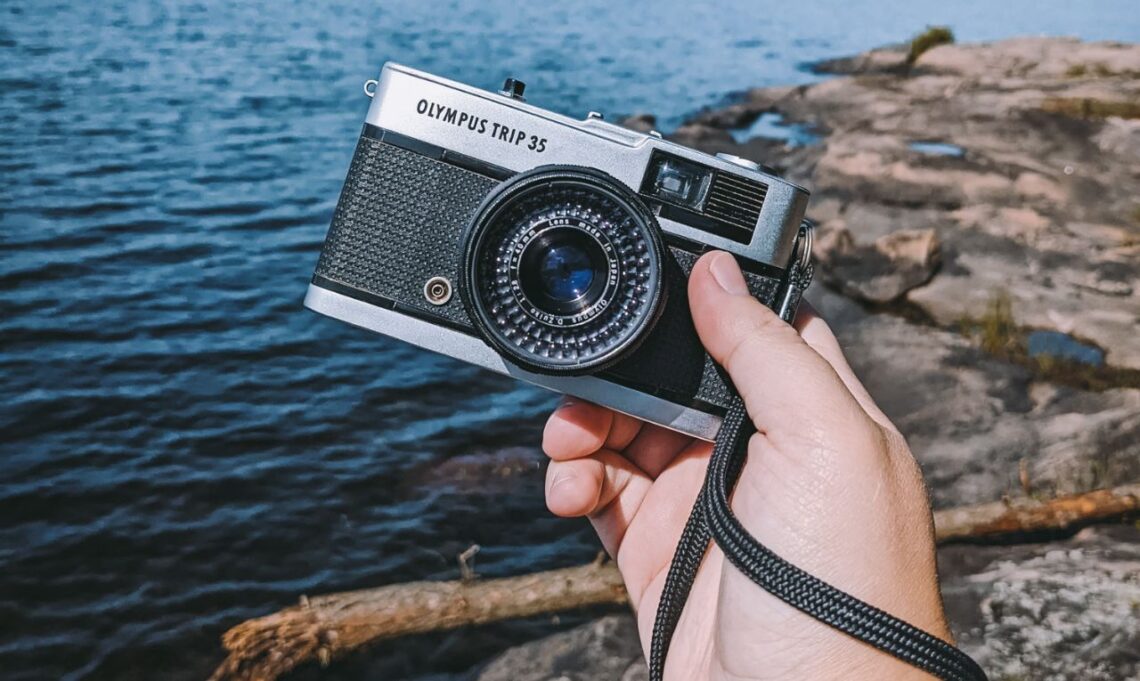
The Olympus Trip 35 is a compact, battery-free point-and-shoot 35mm film camera known for its ease of use and quality. When it was released in 1968, it was marketed as the perfect film camera to take on your travels.
NOTE: Travel is not recommended at this time. These posts are here to serve as inspiration when we can explore again. Hey there – this post likely contains affiliate links, which means I earn a commission (at no extra cost to you) if you purchase from them. This helps me earn a few dollars to run this website.

Imagine yourself as a traveller in the 1970s . Airlines were becoming more popular than ever, with more and more destinations opening up to international exploration. The Grand Tour of the 19th century had felt a resurgence for the everyday person. You only connected with those back at home by postcard and you took photos on film, waiting to share them once you returned.
With over 10 million units sold during its 16-year run, it would be likely that as a traveller in the 1970s, you would have had (or would have wanted) the Olympus Trip 35. How about today? With film photography becoming more popular again, is the Olympus Trip 35 a worthwhile film camera to take on your travels?
What is the Olympus Trip 35?
The Olympus Trip 35 is what is known as a point-and-shoot camera – one that does most of the work for you. The camera has a fixed 40mm f/2.8 lens. The camera uses just two shutter speeds and a selenium photocell as a light metre.
The Olympus Trip 35 was marketed as an easy-to-use, compact camera to take with you on your travels. They are super lightweight, take regular 35mm film and work with a click of a button.
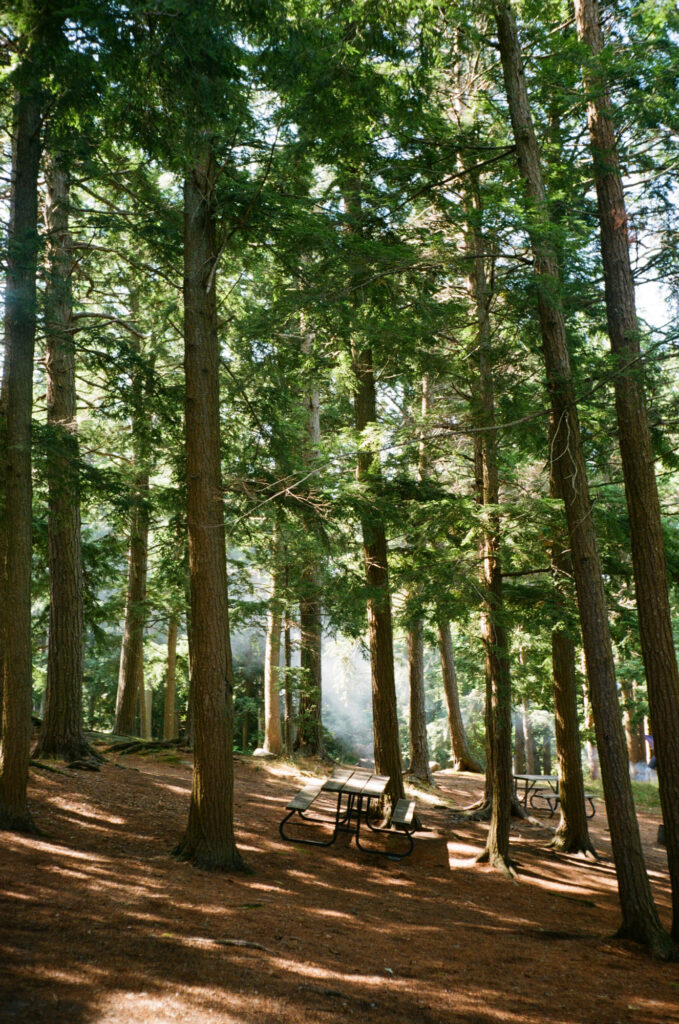
How does the Olympus Trip 35 work
The Olympus Trip 35 doesn’t need a battery to operate, which is pretty darn cool if you ask me. It uses a solar-powered selenium photocell light metre to automatically set the aperture and select a shutter speed.
First up, the Olympus Trip 35 has an ISO range of 25 to 400, which makes it perfect for a film stock like Kodak Gold 200. You can use (the crème de la crème) Kodak Portra 400, but because that film stock is so expensive, I’d use the cheaper Kodak Gold 200 or Kodak Ultramax 400 in this point-and-shoot camera. You could even try a nice black and white film stock, although I haven’t done that yet myself.
The Olympus Trip 35 just has two shutter speeds – 1/40s or 1/200s, which the camera chooses automatically based on the available light. The camera’s aperture ranges from f/2.8 to f/22, which it also chooses automatically when in “A” mode. You can take the camera into Aperture-priority mode by twisting the aperture ring on the lens, but there’s really no need to.
The camera has a hot shoe where you could sync with a flash, although I’ve not tried that yet.
Lastly, the only thing you really need to think about when using the Olympus Trip 35 is the focus setting. The camera has four focus zones marked by four symbols: portrait, two people, a group of people and landscape. It’s relatively easy to figure out what focus range you need, but if you need more specifications, the focus zones are 1 metre, 1.5 metres, 3 metres and infinity. For most travel photos, you’re going to stick to the landscape focus zone.
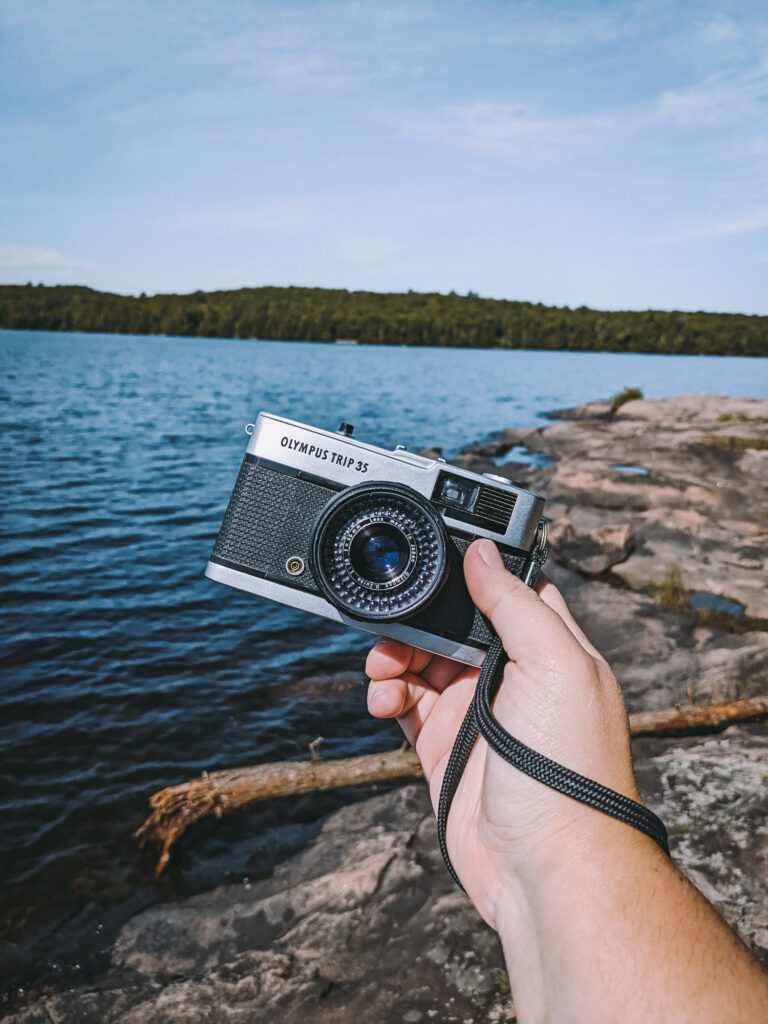
Is the Olympus Trip 35 easy to use?
Once you get the hang of it, yes, the Olympus Trip 35 is so easy to use! The first step is to choose your film stock. The ISO ranges from 25 to 400 so you’ll want to choose a film stock in that speed. (Kodak Gold 200 and Ultramax 400 are some of my favourites).
Next, you need to load the film. There’s a small release button on the left-hand side to pop open the back cover. The 35mm film loads in like most other 35mm film cameras. You need to pop the rewinder knob up, fit in the film and push the rewinder knob back in. Then thread the leader part of the film into the take-up spool making sure that the teeth are grabbing onto the perforated part of the film. Tighten the film by using the film advance wheel, making sure the rewinder knob is turning as you crank the film advance. Close the back of the camera and advance the film three times until the counter is at 0.
Make sure you’ve set your ISO to match your film stock. You can do so by twisting the outer ring of the lens.
Make sure the aperture is set on “A” so that the camera can decide what aperture to use. Once you do that, the camera will decide on either 1/40s or 1/200s for the shutter speed based on the available light.
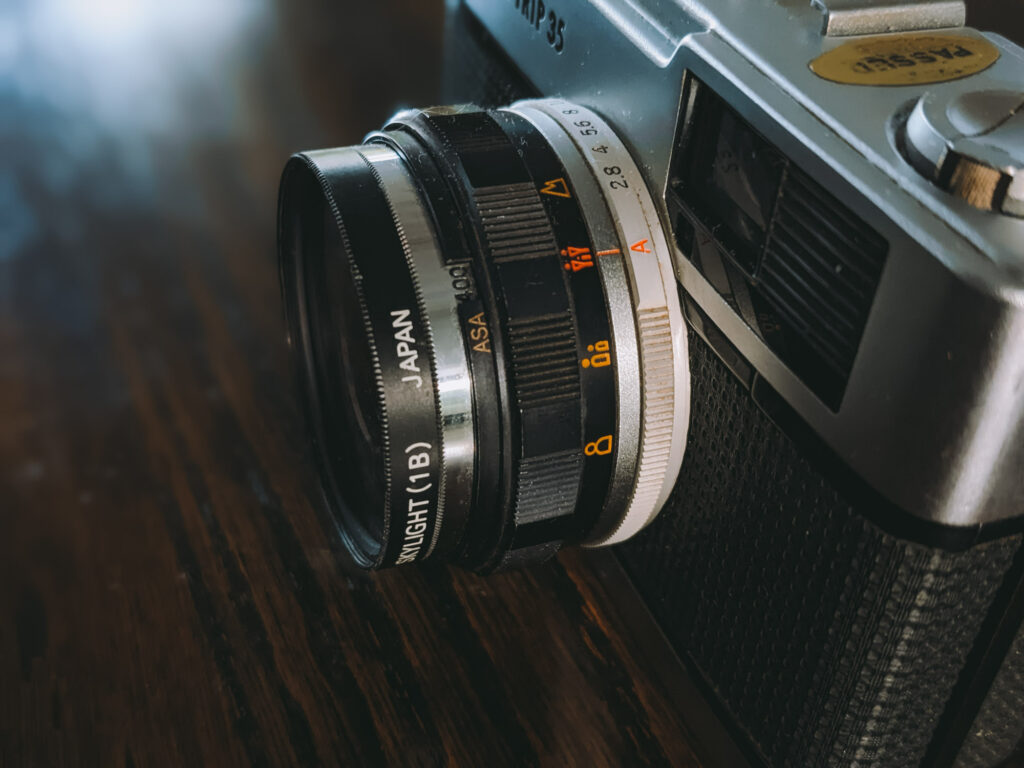
Next, choose your focus zone. If you’re taking a portrait, use the portrait focus zone, if you’re taking a landscape, use the landscape focus zone. It’s pretty simple.
Then you look through the viewfinder you’ll notice that you can see the lens in the viewfinder. That’s because it’s a parallax viewfinder, rather than a mirror system like you see in most DSLR cameras. The viewfinder in the Olympus Trip 35 has parallax markings, which help you frame up an image when your subject is close to correct for this viewing error.
The second, very small window you see under this (which is called the Judas window – don’t ask me why) shows the aperture session and distance symbol that you’re using.
Once you look through the viewfinder, click the small shutter button on the top right to take the picture.
If a small red flag appears in the viewfinder, it just means that the camera has decided there’s not enough light and won’t take the photo.
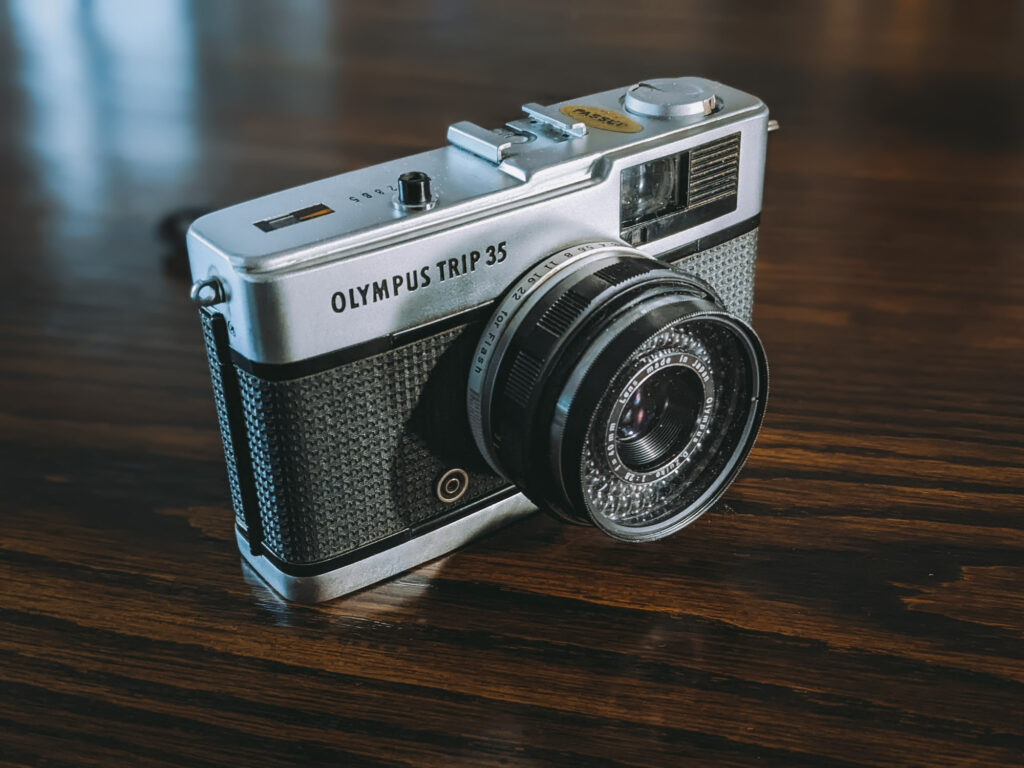
Finding an Olympus Trip 35
I think what sold me on the Olympus Trip 35 was how easy it was to use. I had just started my journey back into film photography and I already had the 100% manual Canon AE-1. I wanted something light, enjoyable and fun to use, while still being vintage.
I think I stumbled across the camera while perusing YouTube and thought I’d look it up. I was surprised at the range of cost. Some were selling for over $300 CAD, while others were listed for only $60 CAD.
I learned that people were buying these cameras cheap, replacing the exterior with new leather and reselling them for a lot more, which is why you see Olympus Trip 35s in fun colours. I ended up looking at three Olympus Trip 35s that were for sale but weren’t functional before buying the one I found. There are two major things you need to look out for when searching for an Olympus Trip 35.
First, make sure the aperture blades aren’t stuck. Sticky aperture blades is pretty common in these vintage cameras. You can test to make sure the aperture works correctly by looking through the front of the lens as you change the apertures and pressing the shutter. The aperture blades should change accordingly, opening and closing with ease. If it doesn’t it’s not the end of the world. There are a couple of tutorials on how to fix this online.
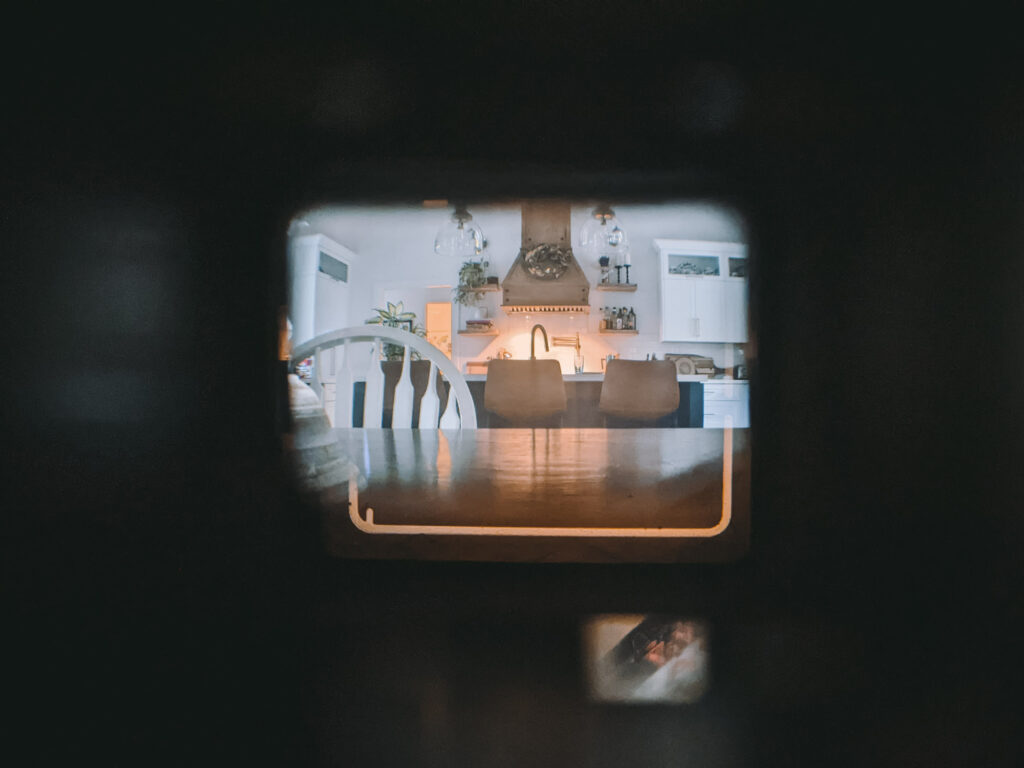
Second, make sure the selenium photocell functions. This is key because if doesn’t work properly, the camera won’t metre light properly and your images won’t come out. To test this, you can place your hand in front of the photocell, covering it completely. Try to take a photo, if the red flag appears, it means that it works. If it takes a photo, then it means the selenium photocell isn’t working.
I looked at three different Olympus Trip 35s where the sellers didn’t know if it worked properly or not. I ended up passing on all three before finding one at a camera store in Collingwood that actually worked.
Then I put just one roll of (relatively) cheap film through it and found it worked perfectly.
The tip is to keep a lens cap on it or in a case while not using the camera. Use this handy guide for more tips when buying an Olympus Trip 35.
Why the Olympus Trip 35 is a great travel film camera?
The Trip name is a reference to its intended market—people who wanted a compact, functional camera for holidays.
For me, I think the joy of it is wrapped up in one image I took while on a camping trip in the summer. I was headed out on a kayak on Stormy Lake near Restoule Provincial Park. I wanted to bring my camera, but because I use my camera for my wedding photography business, there was no way in hell I was putting it in a kayak, even if it was protected by a dry bag. I just didn’t want to take that chance. So I put my phone and my Olympus Trip 35 in a dry bag and set off.
I had just brought my film camera out to take a photo when suddenly, a loon popped out of the lake in front of my kayak. I love the sounds of a loon and had heard them often, but I had never seen one so close. I snapped a quick photo of it with my Olympus Trip 35. I didn’t have to worry about aperture, shutter speed and I knew I already had it on landscape focus, so I just pointed the camera at the loon and snapped the photo.
By the time I put down my film camera and picked up my phone to take another photo, the loon had dove back into the depths and when it resurfaced again a few minutes later, it was too far away.
I had to wait another 3 weeks before I saw that photo, and it was even more magical once I saw the image developed.
So why is the Olympus Trip 35 such a great travel film camera?
Hopefully, by now I’ve convinced you that it is easy to use. The camera is lightweight and compact, plus it won’t accidentally take a photo if you’ve got it stashed in your bag. Plus, since it doesn’t need batteries, all you really need to worry about is making sure you have enough film!
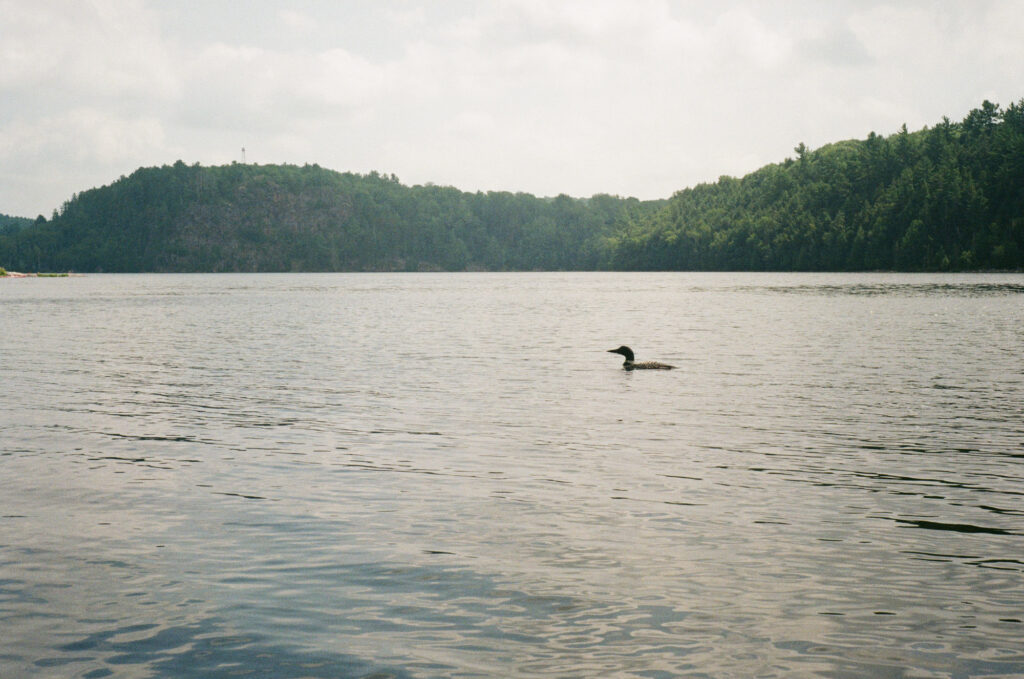
Olympus Trip 35 sample photos
So far, I’ve put four rolls of film through this camera and I’ve loved how it turns out every single time. The camera is so light, it fits in my waist bag, and makes shooting a breeze. I can’t wait to take this on my next photography adventure! Here are some sample photos from the Olympus Trip 35.
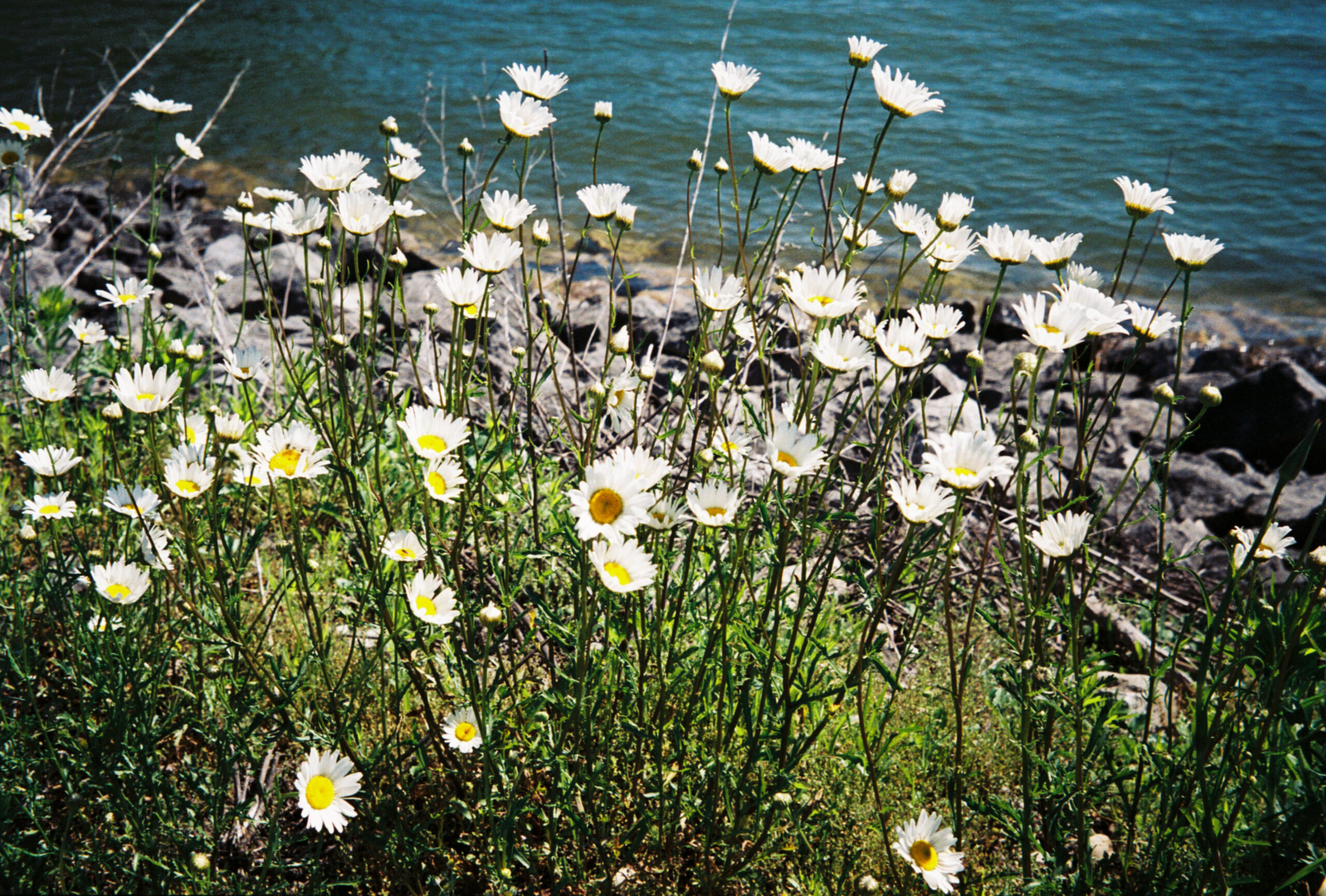
Love film photography? Join Grainery.
I’m pretty new to film, but I’ve absolutely LOVED this new app called Grainery . It’s Instagram-inspired but focuses solely on analog photography. It’s really new, the actual app for iPhone and Android is still in development, but the website works perfectly. And it’s free! Plus, the guy who is developing it is super grassroots and is planning to keep it ad- and algorithm-free.
If you are looking to upgrade to Grainery+, it’s only $3/month, which helps support the developer. (Not sponsored, just something I genuinely LOVE.)

If you love film photography, then what are you waiting for! Join Grainery and follow me @mywanderingvoyage . It’ll be fun!
Love beautiful photos?
I’ve launched a print shop!! After a couple of years of imposter syndrome, I finally launched my own print shop and I am stoked to share it with you!
You can hang up your favourite prints in your home, get a canvas print or even print on metal! Check out the Print Shop now!
Want to know when a new print collection drops and get exclusive discount codes? Sign up for the Print Shop list and you’ll be the first to know!

Olivia Rutt
Olivia Rutt is the travel writer and photographer behind My Wandering Voyage, a travel website helping working millennials find time to travel. She shares insight in trip planning, travel inspiration and photography tips. Olivia hails from southern Ontario, Canada where she works in the media industry between travels. Follow Olivia on Instagram where she shares her travel photos, or catch up with her on Facebook or Twitter.
Further Reading...
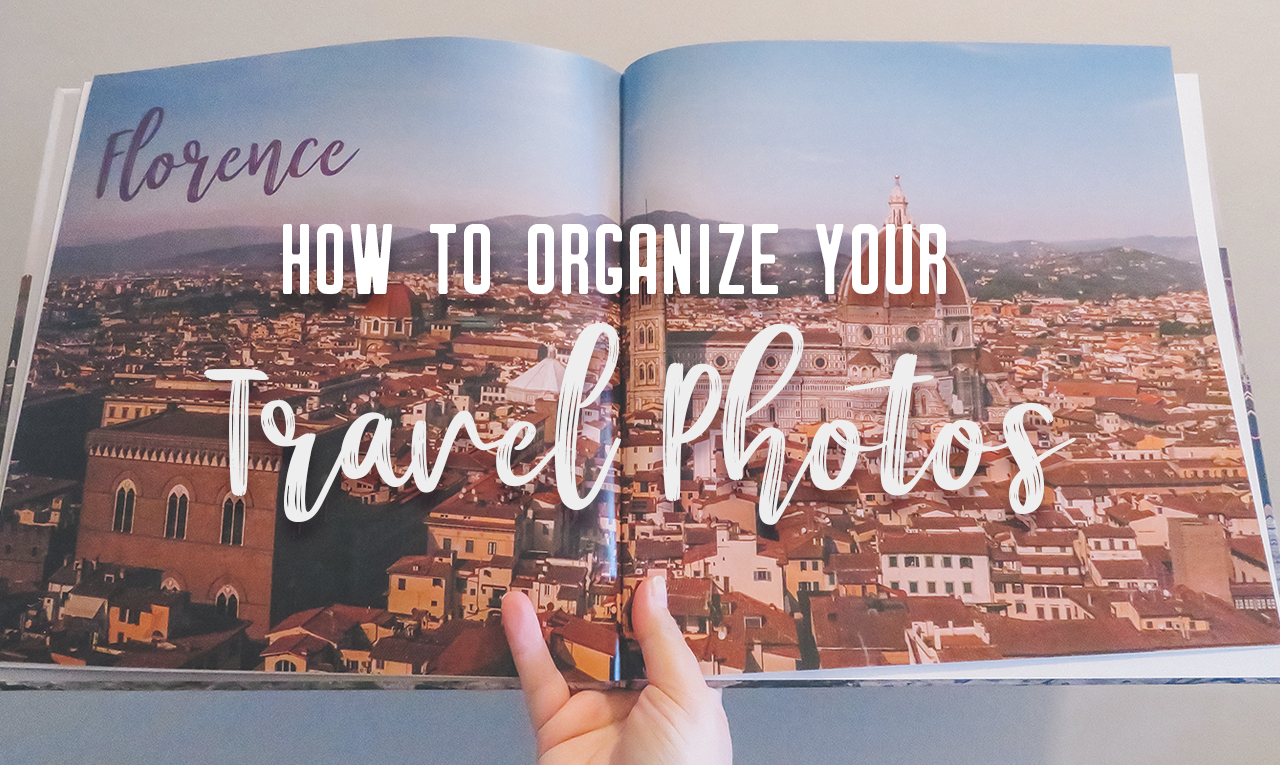
Best way to organize your travel photos
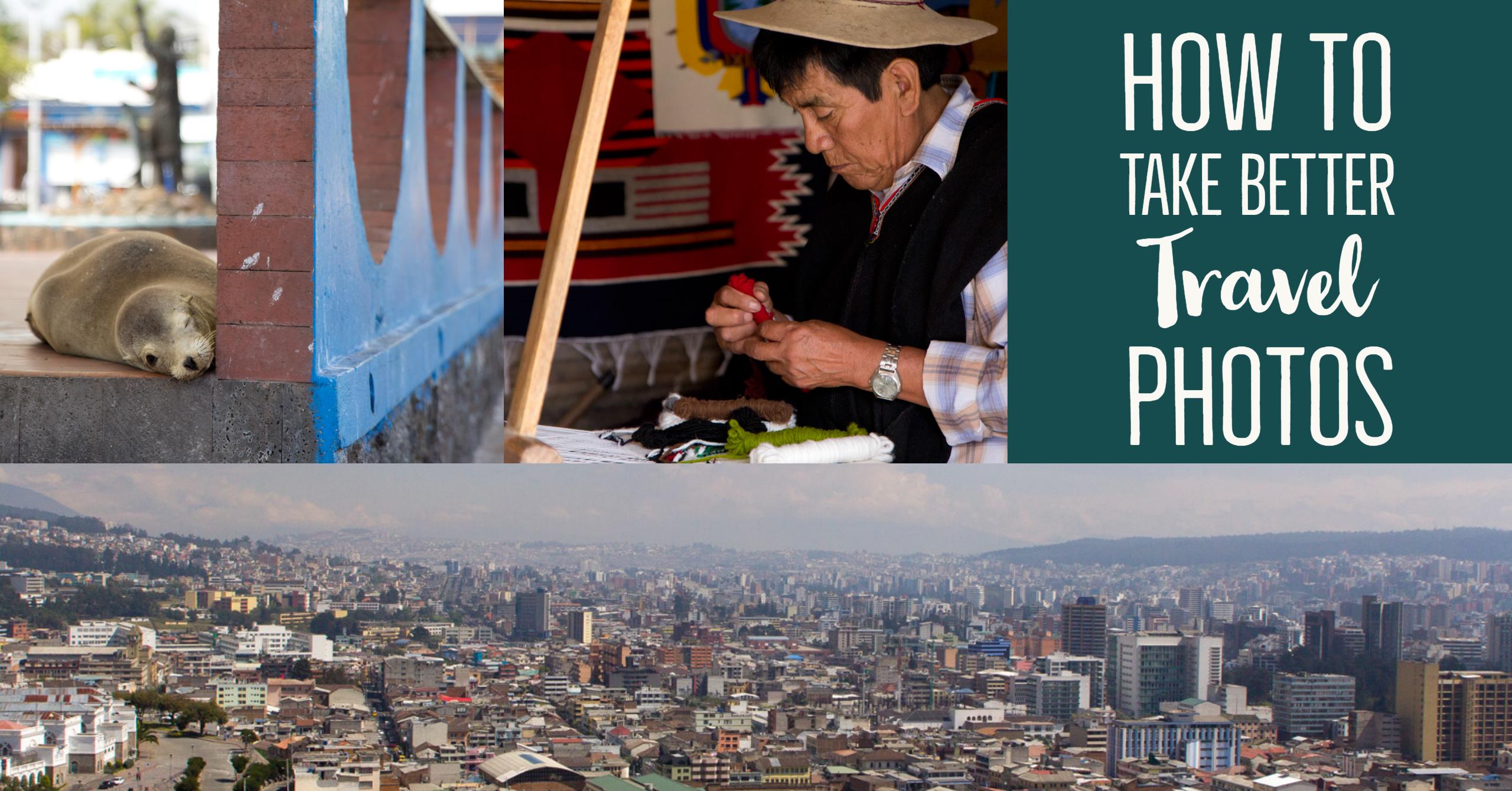
How to take better travel photographs
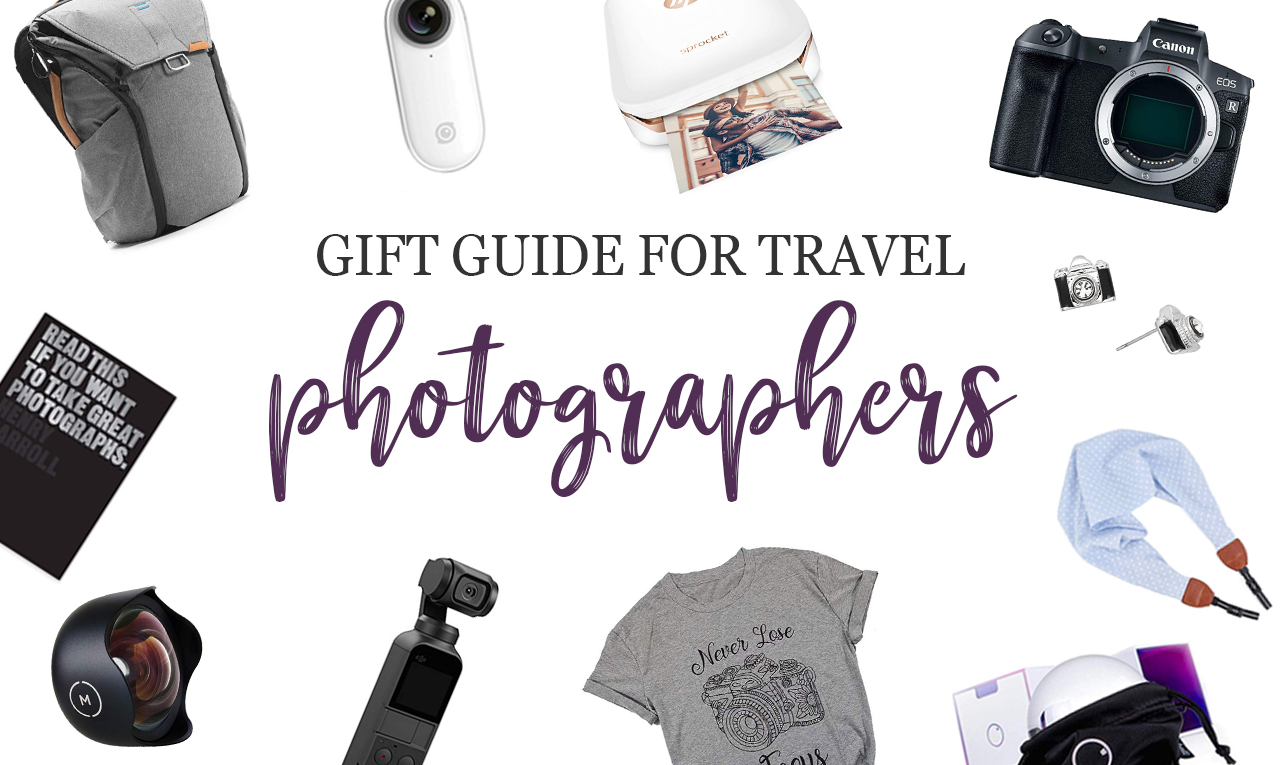
Gift guide for travel photographers
Mywanderingvoyage.

Privacy Overview

- Camera Reviews
- Lens Reviews
- The CCD Sensor
- Mobile Photography
- Half Frames
- MarketPlace
Search ImagingPixel for Images by Camera or Lens
Olympus trip 35 35mm zone-focus film camera.

T alk about the essence of 'iconic' 35mm compact cameras of yesteryears, cameras that help bring photography to the masses, cameras that are as equally functional as it is easy to use, cameras that are automatic but do not require a battery to operate, cameras with super sharp f/2.8 lenses, and the Olympus Trip 35 is always the one camera that will come to mind.
The Olympus Trip 35 , a fully automatic viewfinder camera, is a point-and-shoot 35mm compact model manufactured by Olympus. It was introduced to the market in 1967 as a compact, functional camera for holidays, went on to become very popular among the masses, and sales ended in 1984 after a prolonged production run, with over ten million units sold.
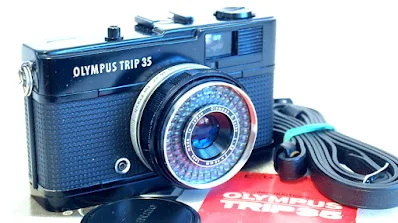
The camera is fitted with a coated non-interchangeable 40mm f/2.8 D. Zuiko lens, acknowledged as being very sharp and capable of capturing high-quality images, and operates as a programmed automatic with only two shutter speeds, at 1/40th sec or 1/200th sec. at apertures of between f/2.8 to f/22.
SCL Photography Guide: The Olympus Trip 35 Film Camera A fresh look at an old classic, to get you shooting your old Trip 35 or perhaps to interest you in investing in this great little film camera. Includes guide to buying, checking, loading and shooting with the camera. Bonus flash guide at the end. Thanks, Rob.
A low-light lock, with a red flag indicator, prevents you from taking under-exposed shots or trying it with the lens cap on.
Production Models
The design of the camera is simplicity itself. Early production units of the Trip 35 are manufactured with a silver shutter release button, with a film ISO speed rating from 25 to 200. Later production units, manufactured after 1978, come with a black plastic shutter release and a higher film ISO speed rating of 25 to 400. The Trip 35 is also available in black, which is much sought after by collectors.

The lens and lens mount are located centrally on the front of the camera, with a viewfinder window on the right front of the top plate, and a flash sync socket on the lower left of the lens mount.
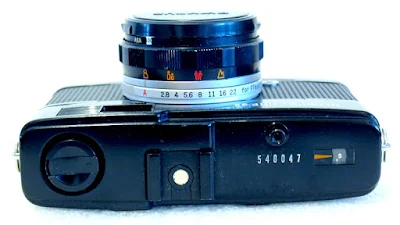
On the top plate are the rewind crank, housed in a nice recessed on the left of the top plate, the accessory shoe (located slightly off-center), the shutter release button, and on the right, the frame counter.

The Trip 35 comes with a plain film back, with only the viewfinder eyepiece and film forward wind at the back of the top plate. The hinge-type film back is opened by pulling down on a latch lever lock located on the film chamber side of the film box.

The bottom plate carries the tripod socket and the rewind release button.

The film box is Olympus easy-load type, with the film chamber, shutter frame window, film guide sprocket, and a multi-slot takeup spool laid sequentially from left to right. Film loading is the normal 2-blank shot to forward the film to frame 1.
Year of Production
If you are interested in knowing when your camera was produced, you need to open the film compartment, remove the pressure plate on the back of the door by sliding it free from its locating pins, and look for the 3-character manufacturer's code on the back of the pressure plate.
- The 1st character or letter (in later models) signifies the assembly plant.
- The 2nd number represents the last digit of the year of assembly, e.g. 6 = 1976, 0 = 1980
- The 3rd number or letter represents the month of assembly, 1-9 for Jan-Sep, X, Y, and Z for Oct-Dec.
For example: If the code reads N2Y, then the production was in November 1972
Viewfinder Readout
The viewfinder is an albada-type bright frame, with frame lines and parallax markings for closer focusing.

There is a second, very small window under this, nicknamed the "Judas window", which shows the current aperture setting and distance symbol which are on the lens barrel.
A small red flag will appear in the viewfinder if the auto-exposure mechanism decides there is not enough light and refuses to fire.
Film ISO Speed
The camera will accept films with an ISO speed, for later models, of 25–400. Earlier models, from the first few years of production, had a maximum ISO speed of 200. A hot shoe and a Prontor-Compur sync connector provide for flash photography.
Zone Focusing
The Olympus Trip 35 focuses manually with a simple four-position zone-focus system, with distance settings displayed on the top scale in graphic form, and a bottom scale calibrated in both meters and feet. Focusing distances are 1 meter, 1.5 meters, 3 meters, and infinity.

Shutter Speeds
In Auto Mode, the shutter speed is set to 1/200th sec, and exposure is automatically controlled by aperture opening, whilst in manual or flash sync mode, the shutter is set to 1/40th sec, and a range of aperture openings from f2.8 to f22 can be selected for the shot.
Battery Not Included
The Olympus Trip 35 is built with a solar-powered selenium light meter, and it does not need any battery for it to run and operate. It is ideal for both the new user just getting into photography or the seasoned operator who wants slightly better control over the aperture setting and zone focusing mode. An accessory shoe and flash sync connector provide for flash photography.
Using The Camera
As with a fully automatic point-and-shoot camera, be it a film or digital, the Olympus Trip 35 is easy and fun to use.

Aside from the need for a roll of film to be loaded into the camera, be sure to set the correct film speed (ASA) setting, by turning the ASA ring in front of the lens barrel so that the ASA speed is displayed in the small opening.
Set the aperture or F-stop ring to 'A' for Auto, and off you go.
For the zone-focusing part of the equation, give it a go at estimating the distance of your subject, or turn the focal ring graphic icons to match the subject of your composition, be a portrait or head-shoulder shot, a three-quarter height shot, a group shop or just a view of the land, sea or urbanscape.
Early Images
A friendly shop assistant showed off his antics.

Do remember to check the zone focus setting as you go on with your shooting assignment. On bright and clear days the 40mm f/2.8 lens can be very forgiving and will stay sharp most of the time, but when things get a little dark and the automatic aperture falls to below f/5.6 you will tend to get blurred images if the zone focusing distance is not just right.
Olympus Trip 35 Instructions: Click here to download from www.buktus.org
Vintage Camera Marketplace by ImagingPixel
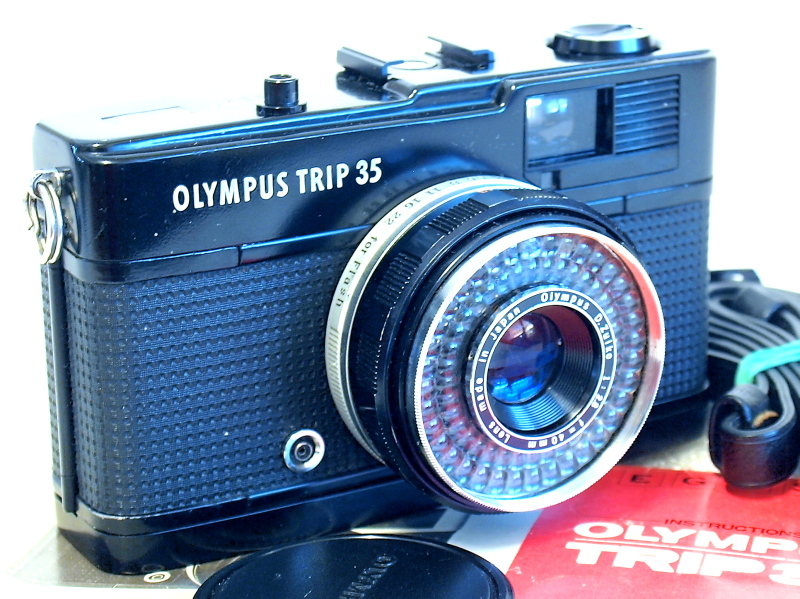
4 comments:

She is nice in black, too, but I like the silver/black better ;-)

Others may not agree with you, but I do believe that the current film camera enthusiasts are more inclined toward the silver/blacks... thanks
Hey thanks for the article. You state that in Auto mode the shutter speed is set at 1/200 and with flash it's 1/40. In fact both shutter speeds are available in auto and it switches at a point around EV 12.5 from f11 1/40 to f5.6 1/200, depending on the available light. It'll shoot down to EV 8.5: 1/40 2.8 and almost up to EV 17: 1/200 f22 in auto mode. The available combinations are 1/40 f2.8-f11 and 1/200 f5.6-f22 and it looks to actually select third-stops across this range, or thereabouts. This can be seen by the needle trap mechanism - there is an armature to determine the shutter speed by how far the armature raises when the shutter is depressed; this engages at one of two different cutout heights with the meter needle (along with a corresponding stepped scale for aperture), depending how far the needle is deflected by the coil/selenium cell circuit. It's an ingeniously simple mechanism - and worth noting that even in the daylight, on a dull overcast day, your shutter speeds can easily be low enough to blur if you don't make an effort to steady the camera.
Thanks for the followup, great!

Popular on ImagingPixel

Lomopedia: Olympus Trip 35
Introduced by Olympus in 1967, the Trip 35 is a 35 mm compact camera that was made and marketed for travelers who wanted something handy and functional to take photos with during their holidays.

The Olympus Trip 35 became popular for its auto exposure system (dependent on a solar-powered selenium light meter), simple zone focusing, and its extremely sharp 40 mm f/2.8 Zuiko lens. It doesn't require batteries, which made them great companions for travelers who may not find access to batteries all the time.
While the Trip 35 only had an ISO range of 25-400 and two shutter speeds (1/40 sec. and 1/200 sec.), it managed to take decent photos without problems at all. Films above 400 ISO were rare and not of high image quality at the time, while the two shutter speeds were enough to allow the Trip 35 to still get correct exposures even in full sunlight or bright fluorescent light without flash.

While it was discontinued in 1984, the Trip 35 remains, until this day, a sought after and well-loved compacts to this day for the fuss-free shooting experience and crisp, high-quality photos it captures.
Photos Taken by Our Community Members

Popular British photographer David Bailey even took part in an advertising campaign to promote the Olympus Trip 35 during the 1970s. Watch one of his Trip 35 commercials below:
Technical Specifications
Film size: 24 × 36 mm Lens: D. Zuiko F2.8, f~40 mm. (4 elements in 3 groups) Shutter: Programmed system. Automatic: 1/40 sec. or 1/200 sec. Manual: 1/40 sec. X sync Film counter: Progressive, self-resetting type Film rewinding: Crank type with rewinding button setting system Focusing: Zone focusing system (4 zone indicators) with distance scale (in meters and feet) Exposure meter: Automatic exposure adjustment by built-in electric eye meter Light measuring range: EV 8 - EV 17 (ASA 100) Film speed setting: ASA 25 - 400 Filter size: 43.5 mm (screw-in) Rear cover operation: Hinge type Accessory shoe: Cordless flash contact Size & weight: 4 1/2 (width) × 2 3/4 (height) × 2 1/4 (depth) in., 14 1/2 oz Viewfinder: Luminous bright frame finder (Magnification 0.55) with parallax correction mark and zone indicators Film loading: EL (Easy Loading) system Film winding: Rear wind-on wheel. Self-cocking to prevent double advances and double exposures
All information for this article were sourced from Olympus Trip 35 on Camerapedia , Olympus Trip 35 on Wikipedia , and The Camera Site .
written by plasticpopsicle on 2013-07-09 #gear #people #videos #lomopedia #review #olympus #olympus-trip-35 #point-and-shoot #lomography #compact-camera #lomopedia
romms , ericography , lizkoppert , peruvianfan , theblues , roxyvonschlotterstein , eelii , paulus74 , rbruce63 , sirio174 , nickpage , danilek , lefolle , fadjaradiputra , clickiemcpete , ksears119 , dutchninjapanda , robertofiuza , double_exposure , tytusek , spookydirt , vicker313 , twizzer88 , jawatembak , noyart , stouf , sifree & neanderthalis .
15 Comments

One of the best cameras ever made.

I really love that camera, it's so sharp and reliable. And, BTW, thanks for featuring one of my pics! :)
Just both my second one! :) First one had the red flag problem so when I was trying to fix it, I drop one screw inside it. Haven't had any time to fix it yet, so I bought a new one that was all fixed up and all :) cant wait to take it out for some photoshoting :)

@stouf Seeing all the Olympus Trip 35 photos in the community, I'd have to agree! I've been wanting to have a handsome black Trip 35 all the more! @vgzalez You're welcome! Great to know you Heads up to @grazie , @twizzer88 , @hewzay , @yapfl , @i_am_four-eyes , @aoizumi , @srmarcus , and @clickiemcpete as well for their impressive Trip 35 snaps! @noyart Good to know you found a replacement! Go out and shoot, NOW! :) Don't forget to show us your snaps! :)
@vgzalez You're welcome! Great to know you found the camera reliable! :)

i love this camera! Very sharp photos, great for street and no batteries needed!
and thanks for featuring my photo! I think I will shoot with it tomorrow

I am a big fan of the Trip 35. I found one last year in a second hand shop for $10. It takes such sharp and clear photos. And it's amazing for low light/night time shots. A true classic!

Good for street. The selenium meter is a bit unreliable now, unfortunately.
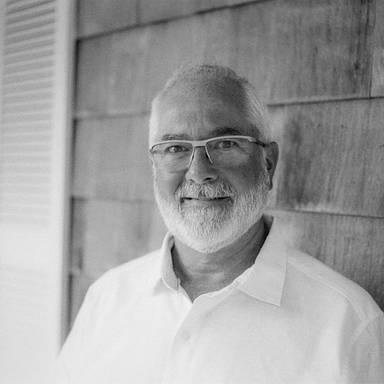
I recently purchased a refurbished Olympus RC35 from Tripman in the U.K. who specializes in refurbishing the Trip 35. He has a very nice website. www.tripman.co.uk/
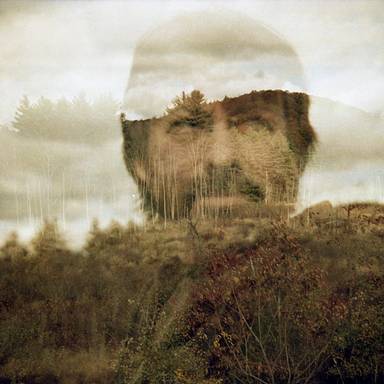
These are fantastic cameras as many have noted. They are relatively cheap and plentiful because literally millions of them were made between the late 60's and mid 80's. Tripman in the UK does nice refurbed and recovered ones and you can usually find his listings on the big auction site. If buying on Ebay, take your time and pick one where the seller has tested to make sure the shutter is working.

Try the awesome Olympus 35 RC! Same very sharp lens, full manual control or time priority!

I just inherited my dads 1979 Trip 35, all my childhood photos were taken with this and it's still going strong. I just gave it a bit of a clean and stuck a Kodak 400Tmax in - can't wait to use it!
A very thorough and considered review, thank you. I do think the Olympus Trip is a lovely way to be introduced to the pace of film photography and getting used to framing a picture and being patient for the shot. Nothing like a little 'cost per shot' to make us slow down and plan our shots a little more. I've just bought my 50th Trip and am gradually rebuilding them from head to toe. If anyone wants to see what I'm up to and maybe download an original user guide, please head here: trip35.co (if ok to show website).
Can anyone tell me wath kind of flash to buy for this camera, a flash that's easy to use
More Interesting Articles
Marce's summer adventures with the sprocket rocket.

Busan-based film photographer Marce takes us back to summer and a trip filled with beautiful scenery and memorable moments, all captured using the Sprocket Rocket 35 mm Panoramic Camera.
@Mathildemagnee on "Lull" – a Film Photography Project and a Two-Summers Long Trek Across New Zealand

In search of something new, @mathildemagnee set out on an adventure spanning two long summers across the regions of Canterbury and Marlborough in New Zealand and captured the experience on 35 mm film.
Tipster: Multiple Exposures and Filter Gels – a Creative Way to Color Your Photos

Have you ever tried to shoot a Lomo’Instant Automat with a colored gel filter in front of the lens? Here is a beginner-friendly tipster to experiment with filters and instant photography.
Lomomatic 110 Glass Lens Camera

The Lomomatic 110 is your compact companion for every adventure! Featuring a glass lens, automatic exposure, day and night aperture modes, controllable ISO settings and a flash, get ready to capture your memories in vibrant, super-sharp 110 frames, with a depth of field you’ve never seen on a 110 image ever before!
Looking Back at Make This a Double Film Swap 2023

We take a look back at the 2023 results of Anca Pandrea's project, Make This A Double, and learn more about the wonderfully ambitious international film swap!
Understanding Film Format Sizes: Comparing 110, 35mm & 120 on LomoChrome Purple

What does it mean to shoot 110, 35 mm, and 120? We have tested each film to show you what the frames of each format really look like. Check out the results!
Community Gallery: The Beautiful Mess of Desks on Film

What do our desks reveal about us? In this gallery, we're taking a glimpse at some of our community members' everyday lives through photos of their desks taken on film, and of course, appreciating these spaces either organized or in a state of beautiful chaos.
Bundle Up and Save!

On the look for a great deal? In need for the perfect gift? Not sure what film to get with your camera? Worry not and discover our budget friendly bundles including sweet discounts and freebies for many different products! Don´t miss a great deal and check them out now!
Available in our Shop
Helena Goñi on Keeping the LomoApparat by Her Side for Every Adventure

Helena Goñi is a NYC-based photographer from the Basque Country in Spain who recently tried out the LomoApparat, taking us on a journey throughout her everyday life!
Lomomatic 110 – The Perfect Travel Companion

Bring something new to your travel photography with our pocket sized analogue camera! Calling all adventure seekers – today we look into the Lomomatic 110 Camera's features and see why it is the ultimate globetrotter must-have.
Introducing Camille Bruya (@cbruya) — North America's Honorary LomoHome of April 2024

In celebration of our fantastic and extremely talented community, the team at Lomography USA is honoring their favorite active Lomographers on our website with "LomoHome of the Month." This time, we're highlighting community member @cbruya for her experimental photography.
Your Quick Guide to Analogue Photography

Don’t know your 35 mm from your 110? Never heard of medium format? Confused about cross-processing? This guide gives a brief overview of everything analogue and you’ll be an expert in no time! Get a head start with film photography with our downloadable 12-page PDF guide.
Home in Hawaii on 35 mm Film With Emily May Jampel

Raised in O'ahu and based in New York City, filmmaker Emily May Jampel has created a body of work that teeters between liminality and intentionality. Going through analogue photographs she's taken on and off film sets, we discuss her early beginnings in film, creative influences, and more.
A Day with Kit, JR, their Bus Sunshine and the Diana Instant Square

In the name of their Idle Theory philosophy, writer Kit Whistler and photographer JR Switchgrass hit the road in 2012 with their orange VW bus named Sunshine. With a Diana Instant Square Camera in hand, JR documented a day in their life to complement Kit's written account.
Recap: FORMAT Festival Diana F+ LomoWalk

We recently teamed up with Format Festival for a special Diana F+ LomoWalk around the streets of Derby. We talked to some of the participants on the walk to find out how they got on with this iconic 120 camera.
Find Out More About

thoughts about photography
Olympus Trip 35 – The holiday camera

The people’s camera, compact, easy to shoot, always ready, fun! Enter the Olympus Trip 35. The camera designed and sold for the masses to take with them on holidays and travel, thus the name Trip. So popular that it sold for 20 years and well into the millions, which can even be seen today on the second hand market. Further made popular by endorsements from David Bailey!
A recent example where this camera shines is where I went shooting with my 11-year-old son, Alec, and he was trying out a film camera himself. We had two occasions of this, the first time I took a medium format rangefinder. After that I did not want to spend time operating my camera so that we can enjoy the time together, so this camera fit the bill perfectly. As a side note, he was using an Olympus Pen EE2, a half frame cousin of the Trip.

The Trip 35 has an amazing following across the world, people just seem to love this little camera. In fact, there are clubs and websites dedicated to it, and a huge restoration community. I bought mine from a restorer that not only ensures the cameras are functional but also gives them new skins in a multitude of colours. It was restored with a red leatherette mini snake skin finish, which even though I was sceptical, adds to the fun. The camera seems to have suffered significant corrosion before being restored, as can be seen at the hinge for the back, but the restoration is top rate and should keep it going for another 40 years. It also has a dented filter ring. Based on the date stamp my camera was manufactured in September 1976.
Olympus first introduced the Trip 35 in 1968 and continued selling them for 20 years until 1988. In that period they made over 10 million copies, which is a very good indication on how popular they were and still are.
They were always an inexpensive camera and due to the sheer number of them manufactured that continues today, where second hand copies can be purchased fully restored for about $US100 or less. Without restoration anything from $2 onwards.
The initial Trip 35 had a metal shutter button, but during the production this was changed to a plastic button as per the one in this article. Otherwise the camera had very minimal changes in such a long production run.
The design of the Trip 35 was based on the original Pen EE cameras, which were very compact as they took half frames in vertical format. Due to advances, Olympus could produce a camera almost as small but shooting a full 35mm frame, thus increasing the quality and the appeal of the camera. Being so lightweight makes it a no brainer to put into the case when packing for a holiday, thus ensuring lots of memories taken on the Trip. This alone would have made it popular but being a camera that struck a cord with so many people, that also ensured the sheer numbers of cameras demanded and produced!
Camera Specifics
The Olympus Trip 35 requires no batteries to operate. It does have a light meter, which is embedded around the fixed lens, but within the filter thread to ensure metering through the filter. As the light meter is selenium based, it works without the batteries but does have a finite time before it stops working. The recommendation is to keep a lens cap on when not in use to lengthen the life of the meter by even decades.

The camera operates in programmed automatic (A) exposure mode, limiting the input by the photographer to only focusing. There is a fixed-aperture setting for flash though. The viewfinder is a standard Albada (which means the rear face of the front lens is half-silvered, which reflects a set of frame lines, painted on the eyepiece lens surround). It also has parallax marks. There is a little cut-out square hole in the bottom right of the viewfinder, which you can see the focus selection you have made. While there is a ridged type face/window on the left of the viewfinder window, it is not a rangefinder, that is there purely for aesthetics.
The viewfinder also carries a little red flag, which pops up when there is not enough light to take the picture (below 1/40 sec with f/2.8) which also disables the shutter. This is handy in the case or with a lens cap on, avoiding mistaken shutter presses. What a great design!
The lens is an Olympus D. Zuiko 40mm f/2.8, with 4 elements in 3 groups. Filter size is 43.5mm screw in. Focusing is achieved manually through scale, either visible through the viewfinder or looking at the lens itself. There are several markings on the lens for focusing which consist of a person (1m/3ft), 2 people (1.5m/5ft), a group of people (3m/10ft) or a mountain (infinity). Note that the third setting of the group of people is marked in red, which was done on purpose, as this is the setting you can leave it on and it will focus on pretty much everything in daylight. There is a scale at the bottom which covers both metres and feet. The closest focus is 0.9m (2.9ft). Unless you are shooting with a flash, that is the only setting you have available to adjust.

The camera only has two shutter speeds, 1/40 and 1/200 of a second which are automatically selected. It will stop down to about f/22. For flash the speed will always be set to 1/40 of a second. The exposure range is from EV 8 1/3 to EV 17 1/6 . Film speed can be selected from ASA (ISO) 25 through to 400 in one third stops, except ASA 32.
Loading film is easy enough, with the leader in the slot, and is advanced using a thumb wheel. The frame number is displayed in a little window on top, with a distinctive yellow arrow pointing to it.
The camera is tiny at 390.5g (13.77oz), and dimensions of W 124.77mm x H 72.67mm x D 57.62mm (W 4.912in x H 2.861in x D 2.269in). The fit is fantastic in your hand with a wrist strap.
The Experience
The first time I used the Trip 35, I felt a sense of freedom. I had what must be a good camera in the palm of my hands and I did not need to take any further gear with me except some extra film. We were off to the Sydney Easter Show, where there is lots of rides and animals to look at and I could put to my eye, adjust focus and snap. The camera would tell me if I got the shot or if there was not enough light.

The next time was when I went out with my son Alec, and it was also good as I got to concentrate on him and his enjoyment with the other Olympus while I also snapped away. The third time is when I must admit I got a little frustrated. I went out alone and found that the actual aspect which made this camera popular, is also the reason it slightly annoyed me. I could not take any control, could not control subject separation in a lot of cases, and focus was very limiting i.e. I could not focus, but only use the generic focus points on the camera. The only manual override I had was to “trick” the camera by adjusting the ASA setting, if I wanted, for instance, to take a picture of a person with lots of backlight.
The lens is very sharp and Olympus did a great job of building such an over performing lens. The downside is that you cannot focus exactly, and you also do not control the aperture to isolate your subject, but with such a great latitude of focus, this is rarely a problem unless you are after lots of bokeh.

All this means is that is that maybe Olympus did hit the market they were after, and very successfully. This was reinforced when Alec picked it up and instinctively knew how to use it.
In terms of performance the metering was usually very accurate. The hit rate was a lot more than I expected, and to be honest, put a lot of cameras to shame. I used both black and white and colour film, and both came out with well-balanced exposures. Not bad for a little fully mechanical point and shoot. The negatives are nice and thick and did not need much work once scanned. Tones and colours are very well captured and if I had not known that they were from the Trip, I could have thought they were from a much more expensive SLR.
The lens is quite sharp and has a good definition of contrast. When I scanned the film I could pick up details that some other cameras would not have captured. The corners are quite sharp in landscape mode, and the distortion, well there is none! The design of this lens is fantastic for capturing a hell of a lot in focus, especially when you set it to the group or mountain symbol.

One little item which while trivial, I do think to mention, is that I enjoyed using the thumb wheel to advance the film. It became very natural to use and fit in with the experience perfectly.
When you see these for sale, do consider getting one. They are great little cameras and are fully mechanical. So if we are ever attacked by aliens, and they fry all of our electronics, when the fighting is over, you will be one of the few people still able to take well exposed pictures. Best word to describe the Olympus Trip 35 is FUN!

David Bailey commercial for Olympus Trip 35: https://www.youtube.com/watch?v=i_Yo3FRPeQw
Well worth watching.
Share this:
- Click to email a link to a friend (Opens in new window)
- Click to share on Twitter (Opens in new window)
- Click to share on Facebook (Opens in new window)
- Click to share on Mastodon (Opens in new window)
- Click to share on Tumblr (Opens in new window)
- Click to share on Pinterest (Opens in new window)
- Click to share on Reddit (Opens in new window)
- Click to share on Telegram (Opens in new window)
- Click to share on WhatsApp (Opens in new window)
- Click to share on Pocket (Opens in new window)
- Click to print (Opens in new window)
You May Also Like

Kodak Retina IIa – Coat Pocket Rocket

Kodak Retinette 1B Type 037 – Fat Boy

Nikkor 35mm PC Lens Panoramic
These are some superb B&W exposures. What post-processing (if any) did you perform on the scans?
Thank you! I don’t do too much. I scan the negatives pretty flat and then I adjust the levels and the curve to control the blacks and whites. Occasionally, when needed, I’ll also dodge and burn using the brush tool. Finally I clone out dust. I find this method gets the best out of the film’s range of tones.
Privacy Overview

Featured Camera: The Olympus Trip 35
November 15, 2022 By Cameras By Max
The Olympus Trip is a favourite for analogue photographers worldwide. Made famous by David Bailey, and being able to be customised easily, the Olympus Trip 35 has become a cult classic that has stood the test of time against many other cameras from the 1960s.

What is the Olympus Trip?
The Olympus Trip 35 was introduced in 1967, and discontinued in 1984, which is considered a long production run for a 35mm film camera. Over ten million Olympus Trip cameras were sold in this time.
Many people wrongly call the Olympus Trip a rangefinder camera, however we would classify it more as a point and shoot with zone focusing.

The Olympus Trip camera is a point and shoot film camera and was marketed towards amateur photographers. T he camera was small enough to put in your pocket and take on trips around the world: this is why it is called the Olympus Trip.
It originally came with a black leatherette, but it looks incredible in different colours. Here are some of the ones we create and sell:
What features does the Olympus Trip 35 have?
The Olympus Trip is really easy to use, and has some cool features that set it apart from other point and shoot 35mm film cameras.
- Zuiko coated 40mm f/2.8 lens : this lens is sharp, and the wide aperture makes it versatile in a lot of situations.
- Automatic settings : the Olympus Trip has two shutter speeds and aperture from f/2.8 to f/22.
- No batteries needed : the Olympus Trip is powered by the selenium meter around the lens. This is also what receives light and tells the camera which aperture is needed.
- Red flag feature : when the camera does not have enough light to take a photograph, a red flag appears in the viewfinder.
- Zone focusing : the Olympus Trip has four focus settings depending on how far away your subject is from the camera.
Using the Olympus Trip 35
We love to test all of the cameras we have in our store, so we took the Olympus Trip on a trip to Cornwall where we tried out all of its features. Scattered throughout this article are some of the images we took during this trip.

Views of the ocean taken with the Olympus Trip
I was really pleased with the images that I received back from the camera.
How does the lens perform?
One thing that surprised me with the quality of the photographs from the Olympus Trip was how sharp the images are across the entire frame. It is also not vignetted at all. Some point and shoot cameras lose their sharpness towards the edges and some have a vignette where the edges are darker. Vignette is not a problem with the Olympus Trip because of its high quality Zuiko lens.

It is also a great focal length for capturing memories and things around you. I didn't struggle at all to get the right frame and composition I wanted.
Is the focus easy to use?
A short answer is yes.
The Olympus Trip has four focus settings . The viewfinder view does not change as you change the focus settings, so you need to know which setting is correct for how far away your subject is. Luckily, this is not hard.
The first setting has the symbol of one person. The first setting is used for close-up photographs , where the subject is less than 1 metre away.
The second setting is of two people, which is to be used for subjects from 1.5 to 3 metres away.
The third setting is a symbol of three people. This setting is used for subjects that are between 3 and 6 metres away.
The final setting is a symbol of a mountain, which is used for anything beyond 6 metres away.
If you ever forget these numbers, they are engraved on the underside of the lens (opposite to the symbols on the top).

Views of the Cornish beach taken with Kodak Colorplus on the Olympus Trip
Is the olympus trip suitable for beginners.
The Olympus Trip was designed and advertised towards amateur photographers, for people to be able to capture their holiday memories easily.
This means that the Olympus Trip has a number of features that make the camera easy to use.
It is highly recommended for people who are new to film and want to capture their own memories and enjoy the experience of shooting film.
It is ideal for starting to get an understanding of how film works and how your images may look. It is a great beginner camera, however if you want to learn the skills of photography in more depth, something with more settings options would be a better option.

If you are completely new to film photography and confused by some of the things we are talking about in this blog, we recommend reading these blog posts.
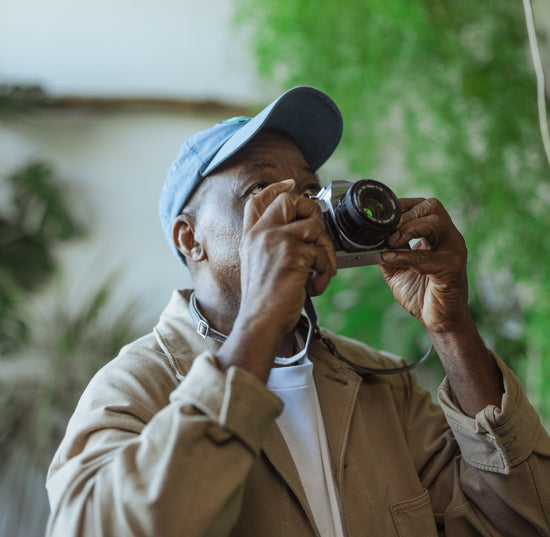
Your Ultimate Guide to Starting 35mm Film Photography

5 of the Best Cameras for Beginners

The Best 35mm Film Cameras for Students
Using Kodak Colorplus in the Olympus Trip
A film stock that has forever been popular with people taking film photographs, we used Kodak Colorplus in the Olympus Trip for these images.
Kodak Colorplus has long been considered a cheap film stock, and not used very often by professionals, but we loved using it and were really impressed by the colours we got back from the roll of film.

Some samples of the images taken with Kodak Colorplus
Can you use the olympus trip in low-light.
Yes, you can. And in fact, we wrote an entire blog post all about it.

Can You Use the Olympus Trip At Night?
Final Thoughts on the Olympus Trip 35
I thoroughly enjoyed using the Olympus Trip, even more than I thought I would. It was easy to take with me everywhere and always ready to take a photograph quickly.
I am really impressed with the exposure across the images and the quality of the lens throughout the different scenarios and subjects.
This camera is a great addition to someone who is new to film photography and wants to capture their memories easily and in great quality.
You can explore our full range of Olympus Trip cameras here . All of our cameras come with a roll of film, film developing discount, a instruction guide to get started, and some Cameras By Max extras.

Which cameras are similar to the Olympus Trip?
Like the Olympus Trip, but don't think it's the one for you?
There are some cameras that are similar to the Olympus Trip that we also highly recommend.
For example, the Olympus Pen EES-2 is pretty much the half-frame version of the Olympus Trip. You can read more about this camera here.
And you can explore our full range of Olympus Pen cameras here too:
Still stuck on which film camera to buy?
Try our film camera quiz. All you have to do is answer a few questions, and then you will get a list of personalised camera recommendations.
Or send us a message on Instagram , send us an email , chat to us on our live website chat, or read some more of our blog posts!

How to Choose Your First 35mm Film Camera

5 of the Best 35mm Film Cameras for Travelling
If you like what we do, but can't buy a camera from us, please consider buying us a cup of coffee! It helps us to keep these resources free, consistent, and accessible.

Article written by: Max
Max is the owner of Cameras By Max. They work full-time repairing and refurbishing all the 35mm film cameras you see on the website. Their favourite camera (at the moment) is the Olympus XA, and their favourite city in the world is Edinburgh.
Take our quiz to find your perfect film camera.
Not sure which camera is best for you?
Congratulations! Your order qualifies for a free planted tree. Free UK shipping when you spend £15.
No more products available for purchase
Your cart is currently empty.
Browse Over 250+ Film Cameras Shop Now
Trusted By Over 40,000 Customers On Their Photography Journey Early Access
Free Worldwide Shipping on Orders Over £200 Learn more
- Russia (GBP £)

Returns & Exchanges
Hassle Free Returns Policy
Free Tracked UK Delivery
Tracked & Next Day Delivery
30 Days Guarantee
Market Leading Assurance
Free Worldwide Shipping
On All Camera Orders
Why the Olympus Trip 35 is a Classic Camera Worth Owning
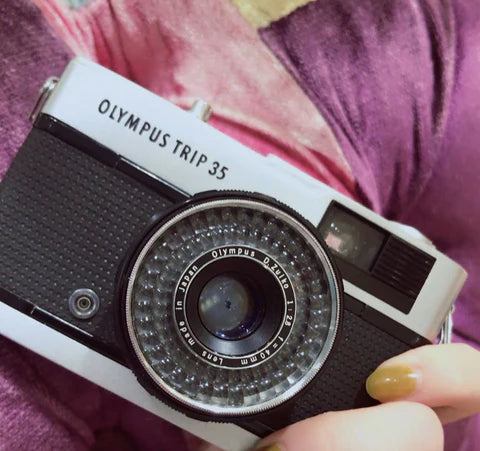
David Johnson | April 14, 2023

History of the Olympus Trip 35
Design and build quality.

Zone Focusing
Light metering, easy to use.

Affordable Price
Shooting experience.

Film Availability
Repairs and maintenance.
Previous Next
Your cart is empty
Subtotal: £0.00 GBP
Free Delivery Service
UK & Worldwide Delivery
Reliable Delivery
Hassle Free Returns
Choose options
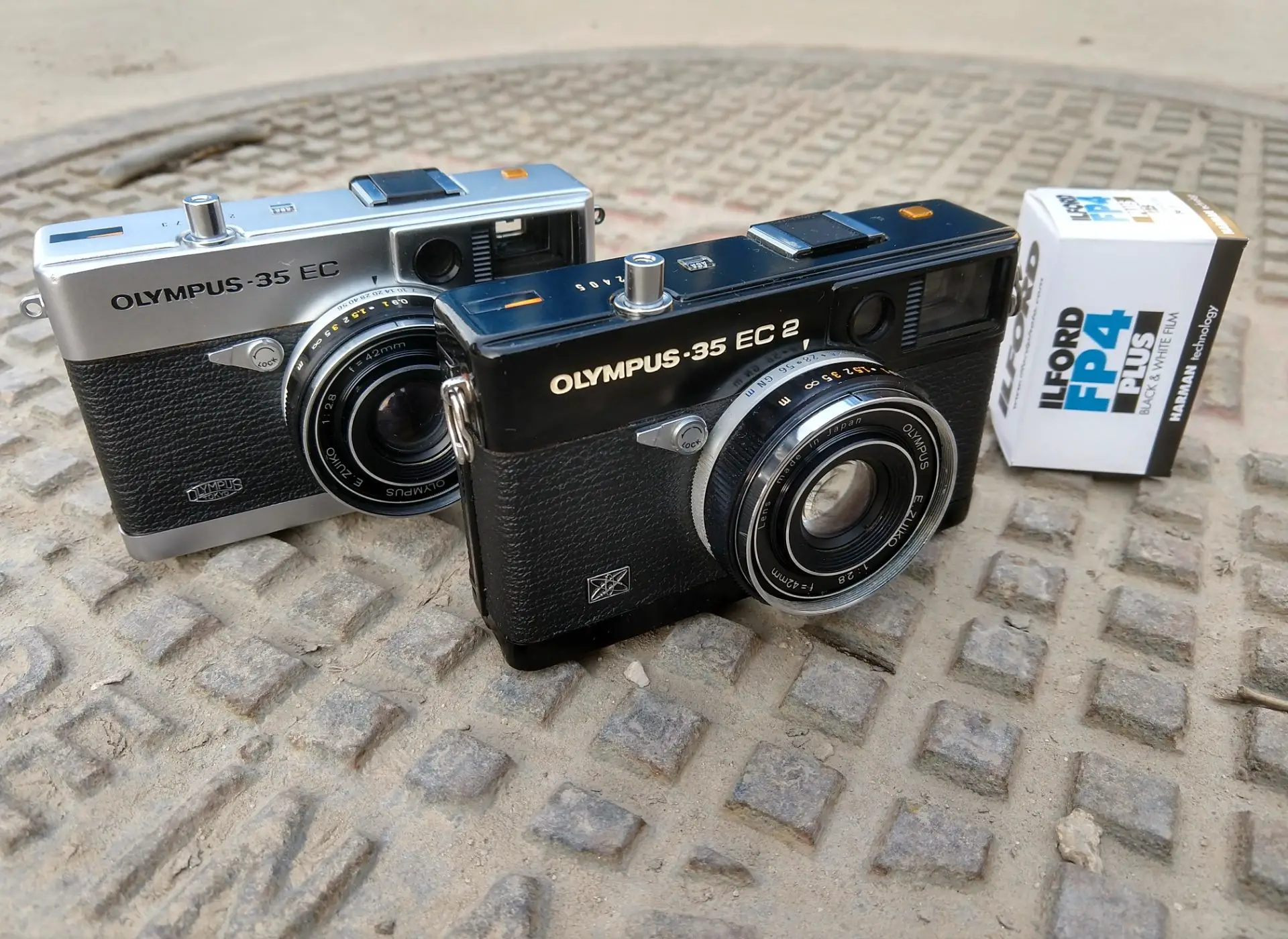
Olympus 35 EC and EC2 Review – An Alternative to the Trip 35 – By Michael Sherman
16 March, 2021
Post Categories:
Share this post:
I discovered the Olympus 35 EC while looking for a 70s rangefinder alternative to the overpriced but highly lauded Olympus Trip 35 . I was impressed at the specs of the Olympus EC line of cameras. They sport a battery operated light meter, a five element Zuiko 42mm lens, a shutter lock and an ISO setting up to 800 ASA.
Nicknamed ‘Elecon’ in Japan, the Olympus 35 EC was first released in 1969. Camera technology was rapidly improving to meet the demand for smaller bodies that had electronic shutters and built in light meters. Olympus introduced the EC and EC2 for those who wanted the ‘full frame’ results of 35mm with the simplicity of fully automatic settings and zone focusing. Better known cameras in this category from the late 60s and 70s include the Olympus Trip 35, the Minolta Hi-Matic G, the Bierette VSN, the Konica C35V, the Russian FED-50 and Mikron-2, the Chinon 35, the Lomo LC-A, the Olympus XA series and the Rollei 35s with scale focusing.

I’m not a huge fan of zone focusing but the viewfinder allows you to see the distance settings as you focus the lens. The build quality is great and it has a nice weight to it with a clean top plate and quiet shutter. While it probably appeals to street photographers, I like to take it out on a short hike or a walk around town.
Zone focus cameras were aimed at amateurs that wanted a simpler way to take pictures. The shutter speed and aperture are set automatically. These features allow you to focus using simple distances in feet, without worrying about the technical details. It takes a little practice, but zone focusing can be easier and faster than focusing with a true rangefinder when shooting street photography.
The approximate distances are shown in the Olympus 35 EC viewfinder using four symbols: close portrait (1 m / 3.3 ft.), head and shoulders (1.5 m / 5 ft.), group shots (3 m / 10 ft.) and a mountain ( / infinity). For hyperfocal distance, set the lens to the ‘group shots setting’, and everything from five feet to infinity will be in an acceptable focus range. The EC2’s focusing ring clicks between ranged focal stops so you don’t have to worry about accidentally knocking it out of focus while shooting.

There are no manual settings on the Olympus 35 EC or EC2, but you can still stop up or down using the ASA (ISO) dial to change the film speed between shots. The ASA (ISO) range runs from 25 to 800. This is useful if you want to bracket your shots or compensate for backlight. For example, if shooting 100 speed film and your subject is backlit, move the dial to 50 ASA instead of 100. You stop down this way when using filters too. Just remember to return the setting to your original film speed when you’re done.
The electronic shutter (a Seiko ESF) is automatically controlled and cocked when you press the button. Take a shot, wind on to the next frame, and you’re ready to press the shutter again. Easy. The camera has a shutter lock feature on the front that prevents unwanted exposures. This also helps the battery to live longer. Flip it up to shoot; push it down to lock the shutter.
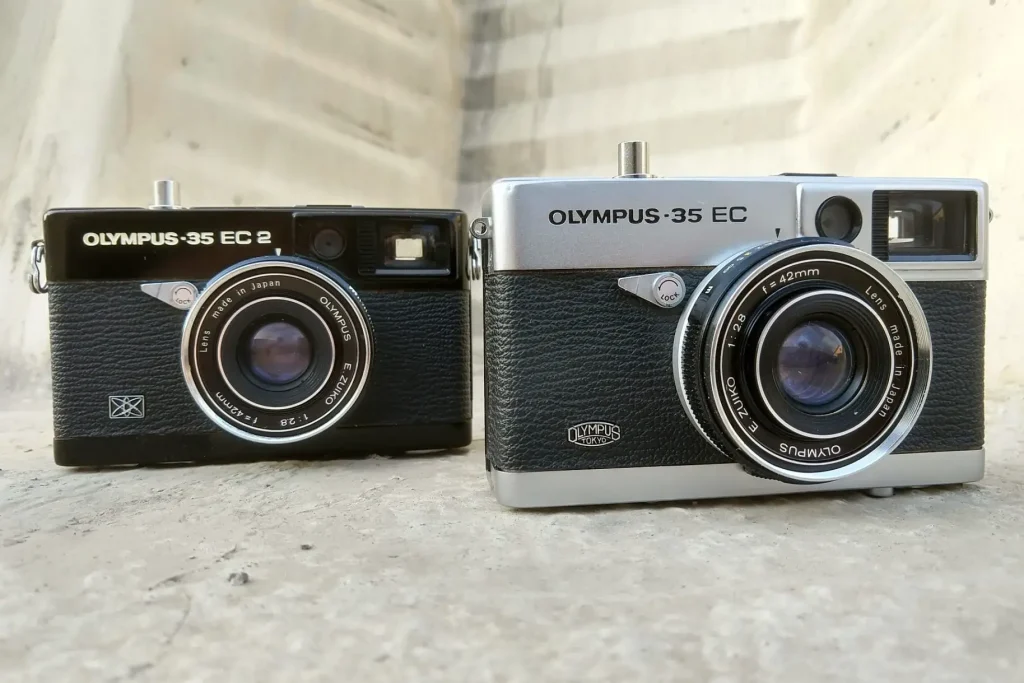
There are two indicator lights on the Olympus 35 EC and EC2. An orange light on top of the camera and in the viewfinder acts as a battery check feature with a half press of the shutter release. It will also briefly light as a slow shutter speed warning if the speeds are between 4 seconds and 1/30 of a second.
In the Olympus EC, a blue light in the finder will appear when a flash is mounted and required to take proper exposures. This same light is green in the EC2. Both cameras offer the ‘flashmatic’ system. Just match the GN (guide number) of the flash you’re using to the numbers on a ring on the lens barrel, and the camera takes care of the shutter speed and aperture automatically.
There is a hot shoe on the top plate, a PC sync socket on the left side and a tripod socket on the base. Although it lacks a self-timer, the shutter button is threaded for use with a shutter cord for long exposures. A small wheel on the back is used to advance the film, which saves space and gives you one less thing to get snagged on in a coat pocket. The film rewind lever is on the bottom of the camera. The film winds on in the opposite direction of most other 35mm cameras – the roll is on the right and moves right to left. The Olympus 35 EC and EC2 also have big viewfinders with zone focus settings.
This first image s one of mine…
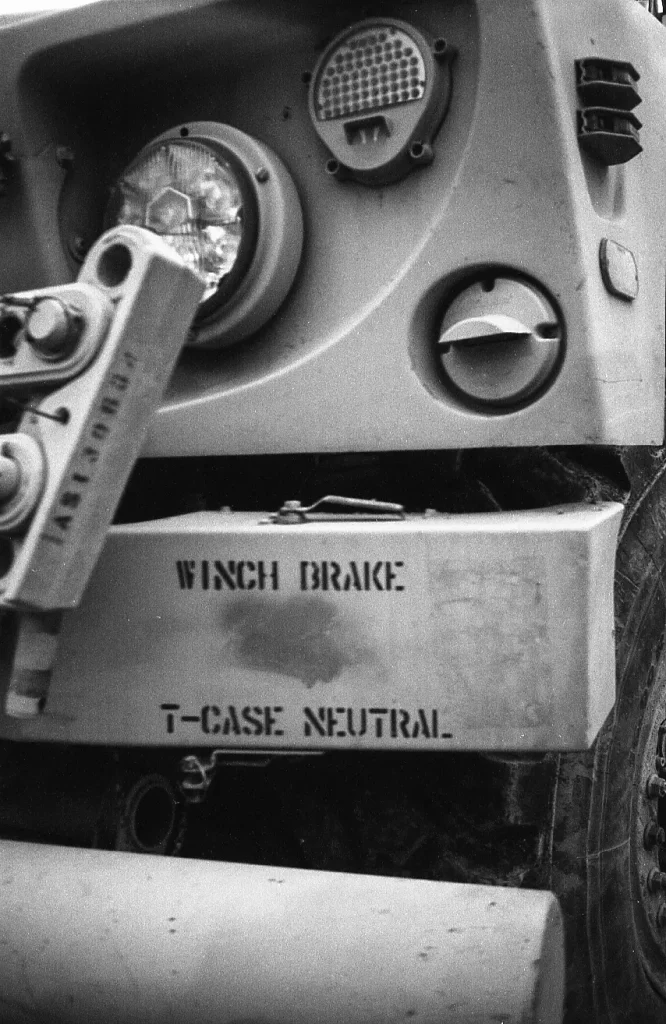
… but since I’m currently in Afghanistan and do not have access to my negatives, I got in touch with a few people I found on Instagram who also shoot with these cameras. Here are a few I was given permission to share.

Olympus EC and EC2 Specs
- Lens: Zuiko 42 mm f/2.8 – 5 elements in 4 groups
- Focusing System: zone focus, rotating helicoid system, 3 feet to infinity
- Filter Mount: 43.5 mm (same as PEN and Trip 35)
- Meter: Cadmium Sulfide (CdS) type (battery operated)
- ISO: ASA (ISO) 25-800
- Shutter: Seiko ESF electronic shutter
- Exposure: fully automatic programmed system
- Flash Sync: with a hot shoe, 1/20 of a second via PC terminal
- Winding Mechanism: thumbwheel film advance – automatically cocks shutter too.
- Dimensions: 111 mm × 67 mm × 49 mm
- Weight: 410 grams
- Battery: 2 x 1.4v mercury battery HM-N type Mallory RM-640 or equivalent – (2 LR44/SR44 1.5v alkaline batteries on one side and tinfoil in the other side works well. Drop the ISO by one stop to compensate for the slight voltage difference).

I really enjoy the high build quality and beautiful design of the Olympus 35 EC and EC2. Their quiet shutter and just right focal length of 42mm makes it ideal for street photography. Seeing the distance settings in the viewfinder is a nice reminder as I compose the shot. Zone focusing at eye level is a feature I haven’t seen in similar cameras from this era. I also like the extremely sharp lens and it’s built in light meter that lets me relax a bit more than I usually would when using a manual focus, tripod mounted camera that requires me to constantly check the settings so I don’t ruin a shot. Unlike a lot of SLRs I use, there are no tiny levers or dials to lift up when setting the ISO, and I really appreciate the thumb wheel and user-friendly controls. The Olympus EC and EC2 are two cameras I’m going to use a lot more often.
Find more similar content on 35mmc
Use the tags below to search for more posts on related topics:
Contribute to 35mmc for an ad-free experience.
There are two ways to contribute to 35mmc and experience it without the adverts:
Paid Subscription – £2.99 per month and you’ll never see an advert again! (Free 3-day trial).
Subscribe here.
Content contributor – become a part of the world’s biggest film and alternative photography community blog. All our Contributors have an ad-free experience for life.
Sign up here.
About The Author
Bob Janes on Olympus 35 EC and EC2 Review – An Alternative to the Trip 35 – By Michael Sherman
Comment posted: 16/03/2021
Leave a Reply Cancel reply
Your email address will not be published. Required fields are marked *
Save my name, email, and website in this browser for the next time I comment.
Notify me of new posts by email.
Michael Sherman replied:
Thanks - I've always wanted an SP...
davesurrey on Olympus 35 EC and EC2 Review – An Alternative to the Trip 35 – By Michael Sherman
Dave, Thanks very much! I also have several other Olympus 35 cameras including a DC, an RC, an ED and some half frame EEDs, but I haven't found an RD at a good price yet. The SPs are also great but high priced too. I also like the Olympus 35 ECR which is basically an EC with a rangefinder focus. Love my OM cameras too! I have too many cameras but most of us do.
Barry Reid replied:
I say stick with the DC - I had the RD, DC and SP at the same time but only kept the DC. I know it lacks control, but that's what I like about it! Quick and easy to use, it still lets you know what's going on with exposure and the lens is also very good. In addition, if you are used to the RD/DC the extra heft of the SP can became a disincentive to actually using it ahead of the smaller RD/DC cameras.
Huss on Olympus 35 EC and EC2 Review – An Alternative to the Trip 35 – By Michael Sherman
The only difference I can see is a change in the color of the light used to indicate a flash. Other than that they're identical.
Huss replied:
That could be true - I'll test it out.
Leave a Comment
Related Posts
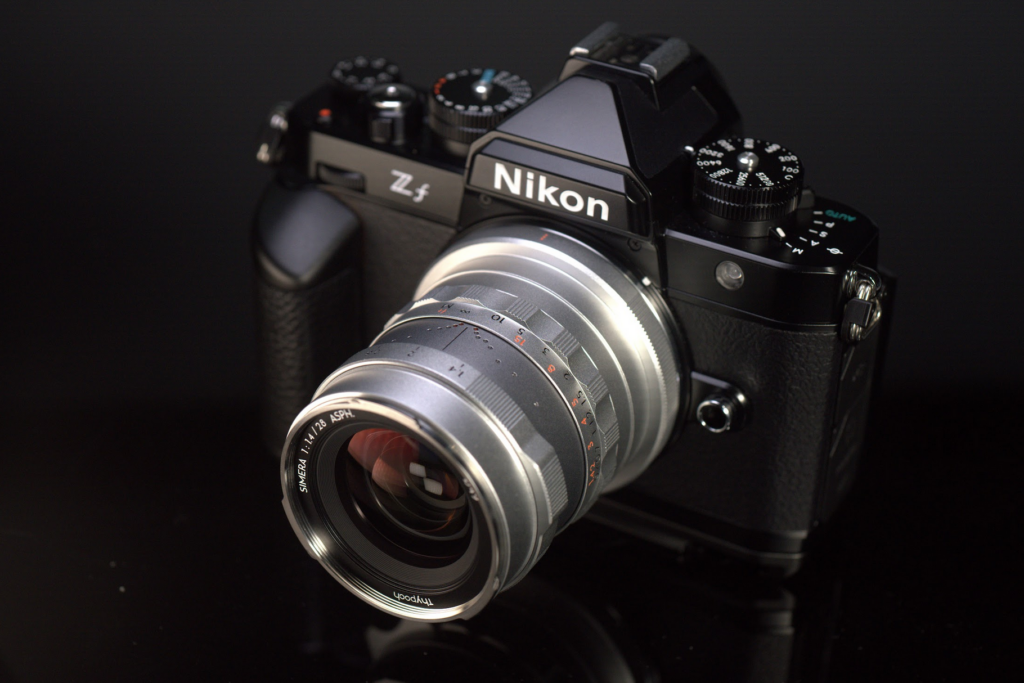
17 May, 2024
By Molly Kate
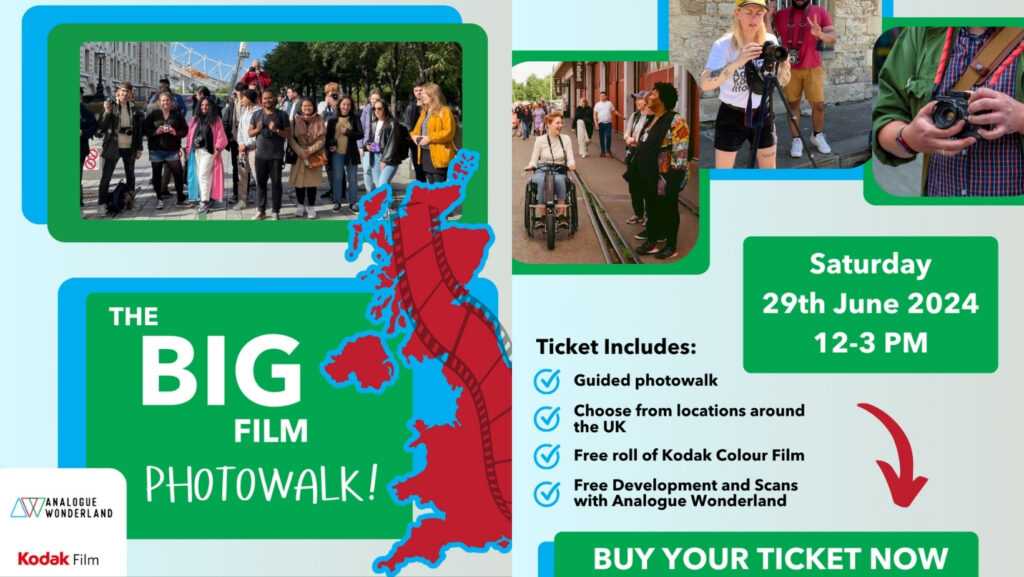
15 May, 2024
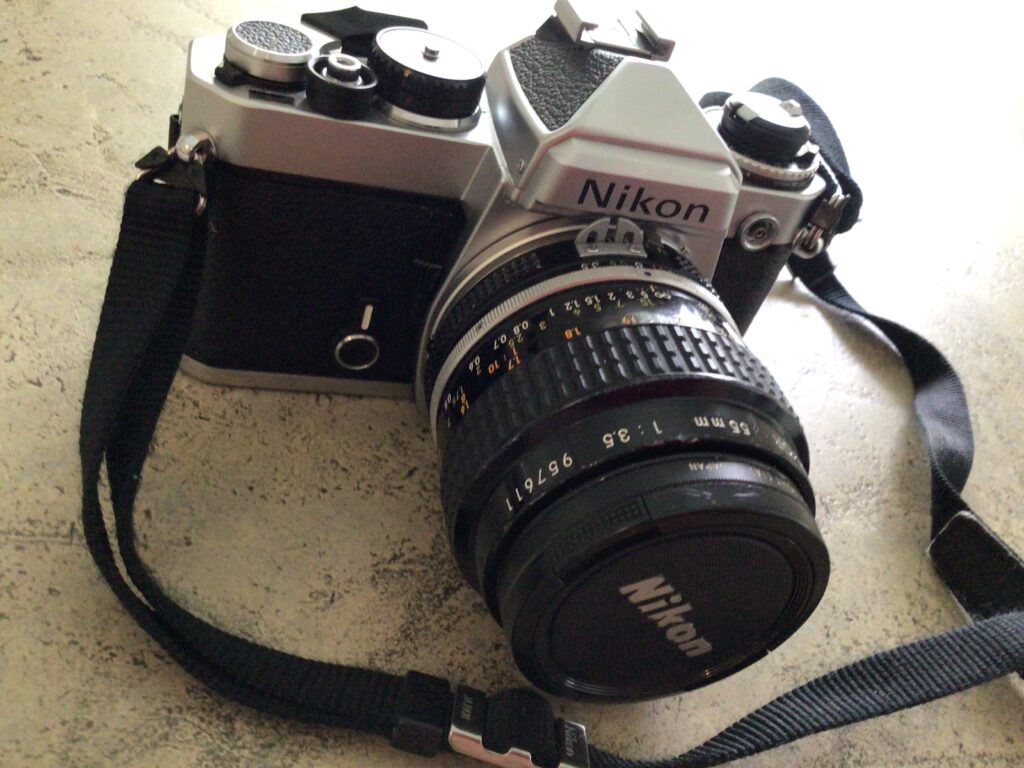
By Ron Duda

13 April, 2024

Photography & Projects
Looking for some inspiration, or just want to flick through the project work and photos?

Reviews & Experiences
If you're looking for photography equipment and peripheral reviews, this is the place to start!

Theory & Reflections

Tutorials & Knowhow
If you want to learn or discover a new technique, build on your skills, or be inspired to have a go at a bit of DIY or camera modification, then you’re in the right place.
Contribute to 35mmc
Paid Subscription
£2.99 per month and you’ll never see an advert again! (Free 3-day trial).
Subscribe here
Content contributor
Become a part of the world’s biggest film and alternative photography community blog. All our Contributors have an ad-free experience for life.

- Скидки дня
- Справка и помощь
- Адрес доставки Идет загрузка... Ошибка: повторите попытку ОК
- Продажи
- Список отслеживания Развернуть список отслеживаемых товаров Идет загрузка... Войдите в систему , чтобы просмотреть свои сведения о пользователе
- Краткий обзор
- Недавно просмотренные
- Ставки/предложения
- Список отслеживания
- История покупок
- Купить опять
- Объявления о товарах
- Сохраненные запросы поиска
- Сохраненные продавцы
- Сообщения
- Уведомление
- Развернуть корзину Идет загрузка... Произошла ошибка. Чтобы узнать подробнее, посмотрите корзину.

IMAGES
VIDEO
COMMENTS
Load a roll of 400 or 800 speed film, set the ASA to 400 and the aperture to it's widest setting of 2.8, and you're ready to go. That's all there is to it. If the scene is too bright for the set aperture of 2.8, don't worry, the Trip's meter is still active in flash mode and will stop down the aperture to prevent overexposure.
The Olympus Trip 35 is so popular because it's very easy to use, it has a great lens and it's ideal for the novice photographer. Also, the Olympus Trip 35 is one of the only 35mm cameras powered by the sun, making it really handy to take on holiday with you. Since 1967 10 million units have been sold, which is a tremendous amount even today.
If you try taking a photo with the Olympus Trip 35 in automatic mode and there's not enough light, you get a little red warning flag pop up in the viewfinder. To get over this, just manually turn the aperture to 2.8, and you're ready to go. Any 400 ASA film will work, but I've gotten my best results with black and white films.
This video is a complete walkthrough of the Olympus Trip 35 Camera. It covers everything you need to know about the camera including everything listed below:...
With the camera set to 'A', based on the light hitting the meter it will choose the most appropriate aperture between f2.8 and f22. It will also choose either 1/40th or 1/200th for the shutter speed. If the amount of light isn't adequate for at very least 1/40th and f2.8 it will simply prevent the photo from being taken.
The Olympus Trip 35 is a cracking little camera that is capable of some stunning results from its 40 mm f/2.8 Zuiko lens. Here is a short guide for getting the best results from this camera. Image from George Rex from Wikimedia Commons. The lens of the Olympus Trip 35 is as sharp as a pin. As good as this camera is it does have its limitation.
Updated on December 29, 2023. Olympus Trip 35 is one of the most popular 35mm film cameras ever produced — and for a good reason. Its battery-free light meter is reliable, the lens is surprisingly sharp, the body is nearly pocketable, and the price is right. This review is a deep dive into the world of this small, mighty camera.
Here are the specs for the Olympus Trip 35 you probably know them already: Focus: Manual by scale, visible through viewfinder. Lens: 40mm f/2.8 Olympus D. Zuiko, 4 elements, three groups. Close Focus: 2.9' (0.9m). Diaphragm: two bladed, diamond-shaped, stopping down to about f/22. Shutter: 1/40 or 1/200, automatically selected. No bulb setting.
The Olympus Trip 35 is a 35mm compact camera, manufactured by Olympus. It was introduced in 1967 and discontinued, after a lengthy production run, in 1984. ... The camera has an ISO range of 25-400, as films faster than 400 were uncommon at the time and delivered reduced image quality. 25 speed allowed the use of Kodachrome, ...
A Minolta was dead on arrival, but a Yashica Electro 35CC and an Olympus Trip 35 were fully functional. However, the Leica was overhauled in time for Asia, so the Trip stayed home. But I was curious to see if the Trip 35 was as good as so many reviewers claim. As you can see, the Olympus Trip 35 is a simple device.
How to Take Photos with the Olympus Trip 35: Step 1: Ensure the camera is wound on. This gets the shutter ready and primed to take a photo. Step 2: Set subject zone focus distance on the lens. The Olympus Trip 35 has 4 settings which equate to focusing zone distances away from the camera (shown on the underside of the lens barrel):
The Olympus Trip 35 is a fully-automatic 35mm compact camera, manufactured by Olympus from 1967 to 1984, during which time over ten million units were sold, though this oft-quoted figure is likely to have included later plastic-bodied Olympus cameras with Trip branding, as the original Trip 35 had serial numbers going up to around 5,400,000. The auto-exposure mechanism is effectively solar ...
This is the kind of review where I have the luxury to start with a standard quote you find anywhere you read about the Olympus Trip 35: "Production of the Trip 35 lasted almost two decades, and Olympus produced more than 10 million of them". ... Wow, this is an extensive article! I enjoyed shooting with my Trip a lot last year, the time has ...
August 28, 2022. The Olympus Trip 35 is a compact, battery-free point-and-shoot 35mm film camera known for its ease of use and quality. When it was released in 1968, it was marketed as the perfect film camera to take on your travels. NOTE: Travel is not recommended at this time.
The Olympus Trip 35, a fully automatic viewfinder camera, is a point-and-shoot 35mm compact model manufactured by Olympus. It was introduced to the market in 1967 as a compact, functional camera for holidays, went on to become very popular among the masses, and sales ended in 1984 after a prolonged production run, with over ten million units sold.
The Olympus Trip 35 became popular for its auto exposure system (dependent on a solar-powered selenium light meter), simple zone focusing, and its extremely sharp 40 mm f/2.8 Zuiko lens. It doesn't require batteries, which made them great companions for travelers who may not find access to batteries all the time.
Camera Specifics. The Olympus Trip 35 requires no batteries to operate. It does have a light meter, which is embedded around the fixed lens, but within the filter thread to ensure metering through the filter. As the light meter is selenium based, it works without the batteries but does have a finite time before it stops working.
The Olympus Trip 35 was introduced in 1967, and discontinued in 1984, which is considered a long production run for a 35mm film camera. Over ten million Olympus Trip cameras were sold in this time. Many people wrongly call the Olympus Trip a rangefinder camera, however we would classify it more as a point and shoot with zone focusing.
The Olympus Trip 35 is a compact 35mm viewfinder camera released in the late 1960s that sold millions of units and had a long production run. It's a famous benchmark camera for sure. ... The first time I used my Trip 35 was a trip (see - a trip!) to Aotearoa/New Zealand in 2019 with my daughter who had been shooting my old FM for a couple ...
The Olympus Trip 35 features a modern, straightforward appearance. It has a black synthetic leather covering over a metal body. The camera is really small and barely weighs 400 grammes. It is ideal for carrying around because it fits comfortably in your pocket. The camera is quite durable and has superb build quality.
The Olympus Trip 35 uses four easy "Zone" settings for focusing a frame. This design feature saves much time having to focus the frame for sharpness. It means anyone from partially sighted to the blind could take sharply focused photographs. Head - 1 m.
Better known cameras in this category from the late 60s and 70s include the Olympus Trip 35, the Minolta Hi-Matic G, the Bierette VSN, the Konica C35V, the Russian FED-50 and Mikron-2, the Chinon 35, the Lomo LC-A, the Olympus XA series and the Rollei 35s with scale focusing. ... Although it lacks a self-timer, the shutter button is threaded ...
Get the best deals on Olympus Trip 35 Film Cameras when you shop the largest online selection at eBay.com. Free shipping on many items | Browse your favorite brands ... Time: newly listed; Price + Shipping: lowest first; Price + Shipping: highest first; Distance: nearest first; Gallery View; 929 Results. Model: Olympus Trip 35 - Remove Filter;